#Mid-Cretaceous North Africa
Text
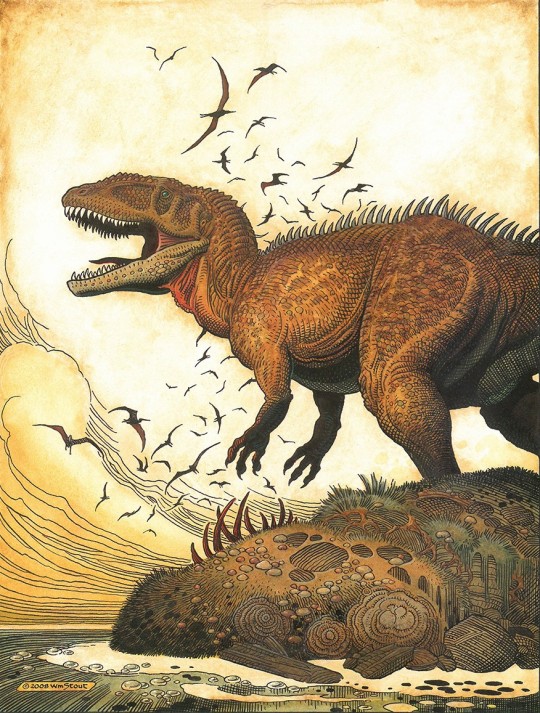
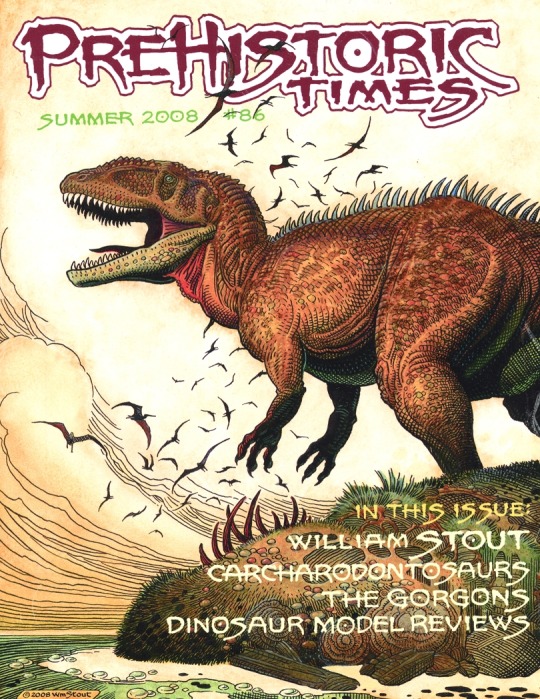
"..."SHARK-TOOTHED LIZARD," AN ALLOSAURID THEROPOD FROM MID-CRETACEOUS NORTH AFRICA."
PIC(S) INFO: Spotlight on the original painting and published cover art to "Prehistoric Times" Magazine #86 (Summer 2008), artwork by William Stout, featuring a Carcharodontosaurus “shark-toothed lizard”, an allosaurid theropod from mid-Cretaceous North Africa.
EXTRA INFO: Carcharodontosaurus is a representative of a family of dinosaurs that may well turn out to be the largest meat-eating dinosaurs of all.
Resolution at 876x1157 & 810x1048.
Sources: www.illustrationhistory.org/artists/william-stout & https://blog.everythingdinosaur.com/blog/_archives/2008/07/21/3803292.html.
#Palaeo Art#William Stout Art#Carcharodontosaurus#Prehistoric Art#Prehistoric#Prehistoric Times#Dino Art#Dinosaurs#Dinosaur Art#Allosaurid#Mid-Cretaceous#Shark-Toothed Lizard#Illustration#Prehistory#North Africa#Allosaurid Theropod#Dinos#Theropods#Prehistoric Times magazine#Magazines#Dinosaur#Prehistoric Times Magazine#William Stout Artist#William Stout#Mid-Cretaceous North Africa#Cover Art
2 notes
·
View notes
Text
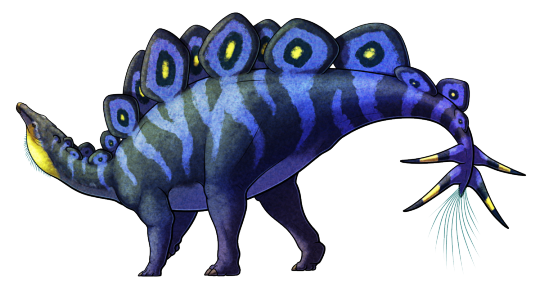
Strange Symmetries #11: Step Up To The Plate
Stegosaurs are some of the most popular and recognizable dinosaurs thanks to their unique appearances, with small heads, elaborate back plates, and spiky thagomizer tails.
Closely related to the ankylosaurs, they first appeared in the mid-Jurassic about 170 million years ago. While they lasted until at least the mid-Cretaceous (~100 milion years ago), their heyday was in the latter half of the Jurassic, ranging all across Asia, Europe, Africa, and North America – and the North American species like the eponymous Stegosaurus developed especially elaborate plates in a distinctive asymmetrical pattern, not arranged in pairs like most other stegosaurs but in alternating rows along each side of the midline of their backs.
Hesperosaurus mjosi lived around 156 million years ago during the late Jurassic, in what is now Wyoming and Montana in the Western United States. It was closely related to Stegosaurus but was a little older and a little smaller, about 5-6m long (~16-20').
Much like its more famous relative its plates seem to have alternated along its back, which may have been an adaptation to maximize visible surface area while minimizing the number of plates, saving on the energy needed to grow such large elaborate ornamentation.
Hesperosaurus might also represent a rare case of possible sexual dimorphism in non-avian dinosaurs, with wider more rounded plates potentially interpreted as belonging to males and taller pointed plates belonging to females.
———
NixIllustration.com | Tumblr | Twitter | Patreon
#science illustration#strange symmetries#paleontology#paleoart#palaeoblr#hesperosaurus#stegosauridae#stegosauria#thyreophora#ornithischia#dinosaur#art
534 notes
·
View notes
Text
file : interesting creatures (#1): spinosaurus !
info requested by anon! rhykar copypasted the ENTIRE spinosaurus fun facts post in our drafts onto this post; therefore, thank us both for this one!
the spinosaurus aegyptiacus was a spinosaurid dinosaur that lived in what is now north africa, its reign taking place in the mid and late cretaceous period around 93.5 to 110 million years ago, in the cenomanian and albain ages. it went extinct near the end f the cretaceous period.
the spinosaurus aegyptiacus' habitat consisted mostly of mangrove forests and tidal flats (muddy, marshy areas of mostly flat land that tend to be covered in sea or delta water). most of the area it lived in included the land that now harbors egypt and morocco.
spinosaurus fossils have been found in egypt, morocco, tunisia, libya, kenya and algeria, in the bahariya formation (egypt)*, aoufous and tegana formations [kem kem beds] (morocco), chenini formation (tunisia), cabao formation (libya), turkana grits formation (kenya), and gara samani, algeria, as well as the ain el guettar formation, also in tunisia. (fossils of similar spinosaurid have been found in thailand, southern england, brazil, niger, laos, and the isle of wight, among others. pelvic bones and vertebrae found to belong to the spinosaurus aegyptiacus have also been found on the isle of wight.)
the first spinosaurus aegyptiacus fossils were found in the bahariya oasis, in the western egypt desert! these fossils were discovered in 1912, and the spinosaurus was named by paleontologist ernst stromer. the original remains were destroyed in world war 2, on april 24th, 1944.
"spinosaurus" translates from latin. it literally just means "spined lizard."
as is generally obvious knowledge, jurassic park was ridiculously inaccurate. there's a lot, but here's a few!
1: the spinosaurus in the movie had inaccurate jaw strength; a real spinosaurus, who would probably have never even encountered a tyrannosaurus rex, would never have had to adapt to develop a bite force strong enough to break a nearly fully-grown tyrannosaur's neck. (probably not any tyrannosaur- not just the rex.)
2: the nasal horn on the spinosaurus in the movie was unrealistically sharp; paleontology has generally shown that it was probably more blunt.
3: the lacrimal ridges on the spinosaurus in the movie were too small for a spinosaurus the age of the one in the movie. a scientific accuracy would have shown a spinosaurus with a much bigger and more developed set of lacrimal ridges.
4: it is trivial knowledge that the spinosaurus aegyptiacus was bigger than the tyrannosaurus rex; the one in the movie was barely a handful of inches taller than the tyrannosaurus rex it killed; that tyrannosaurus rex was also a juvenile.
we used to nearly collectively think that the spinosaurus hunted in deep rivers and on ocean shores, but recent studies have shown substantial evidence that the spinosaurus was more like a gigantic, evil, probably very smart reptilian heron from hell.
spinosaurus most likely spent more time on the river shores of their north african habitats than inland. evidence of this conclusion includes:
a) its nostrils are positioned toward the middle of its snout, suggesting it could mostly submerge itself in order to hide from territorial rivals.
b) its pelvis was smaller than most other large carniverous theropods, which suggests that it used the things attached to said pelvis, the tail and hind legs, to chase after quick-moving small riverside creatures and assist itself in submerging into rivers when it had to hide.
c) the vertebrae of its tail was also oddly loosely connected, which suggests it used it as a sort of balance to swim or run after riverside prey rather than using it as an aid in deep-sea plunder.
recently discovered evidence suggests that the spinosaurus may have been covered in a skin membrane that could change color, which would have assisted in temperature regulation in cold rivers and potentially have aided in attracting mates and intimidating other dinosaurs. the membrane may have also enabled the spinosaurus to act something like the indominus rex, changing its color to camoflauge itself with its surroundings to hunt, or to hide if a water source was not available or safe to hide in.
we used to think the spinosaurus's sail was used solely for swimming and temperature regulation. but recent discoveries seem to suggest otherwise- the sail may have been used for social displays or species recognition. some also believe the sail was used to store water and lipids in case a river any individual spinosaurus lived near began to dry up.
*1: the particular location mentioned, in more specifics, would be the bahariya oasis in the western desert of egypt.
sources : the dominating source i'd like to give credit to for the information in this post is rhykar, my lovely nerdy professional ghost hunting boyfriend, fellow owner and creator and primary organization person of this account!
send an ask if you want more info, or if you've got more to share! please use this post as a source if you post or use information you found on it!
#+ file : creatures#+ subfile : dinosaurs - spinosaurus#+ researcher : hayle#dinosaurs#spino#spinosaurus#spinosaurus aegyptiacus#fun facts#jurassic park#jurassic park inaccuracies#africa#african dinosaurs#prehistory#prehistoric creatures#spinosaurus facts#dinosaur facts
2 notes
·
View notes
Text
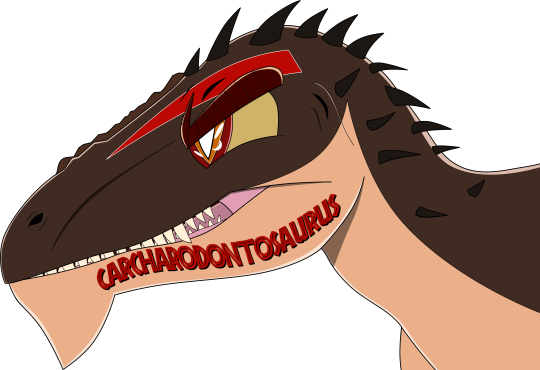
Lived around the mid-Cretaceous period, discovered in the early 20th century, known for his shark like teeth, this dinosaur is known as one of the biggest carnivorous dinosaurs ever discovered. The Carcharodontosaurus, A.K.A, Shark-Toothed Reptile. He's estimated to be 45 feet long and weights 11 tonnes. Bigger than the Tyrannosaurus Rex, but slightly smaller than the Giganotosaurus. He lived in North Africa during the Cretaceous period, around 100 to 93 million years ago. Also in North Africa was the Spinosaurus, a larger predator, and multiple herbivores for Carcharodontosaurus to hunt down and feast on.
Some studies shown that Carcharodontosaurus, due to his eyes being on the side of his head, may have pretty limited vision, and binocular vision that is compared to that of a Crocodile. Despite being bigger than a T-Rex, his brain... Not so much, it's much smaller than a Rex's brain, and many people thought that the dinosaur is a stupid dumb-dumb.
Donty's bite force is around 20,000 newtons, which is pretty strong in its own right. And he probably ran up to 20 mph, pretty fast for a big boy like him!
To learn more about Donty, feel free to lookup the Wikipedia page. Overall, Carcharodontosaurus is a pretty cool and intimidating predator.
#dinosaur#carcharodontosaurus#jurassic park#jurassic world#digital art#dinosaurs#digital drawing#digital fanart#fanart#prehistoric
3 notes
·
View notes
Text
youtube
Welcome to the Juras-Sick Park-Cast podcast, the Jurassic Park podcast about Michael Crichton's 1990 novel Jurassic Park, and also not about that, too.
Find the episode webpage at: Episode 37 - Bungalow.
In this episode, my terrific guest Melissa Ray joins the show to chat with me about:
melding the novel and the film together, differences between the film and the novel, like discussions around feminism, better versions of Ellie and Lex in the film, symbolism in the baseball and baseball mit, daddy issues, carrying baseballs and night vision goggles around, how did Lex and Tim's parents meet?, Ellie is conclusively not dating Alan Grant, and Grant is a childless widower, Sattler's portrayal, black and white symbolizing differences between Malcolm and Hammond in the film, the two "female ends" of the seatbelt in the helicopter ride to Isla Nublar foreshadowing the all-female breeding animals, overanalyzing movies today, John Williams' soundtrack, technological advancements in cinematography, Nedry's demise, reading into Hammond's fall, Aristotelian tragedies, incorporating mystery, and much more!
Plus, check out Melissa's Movie Night Lights!
Plus dinosaur news about:
A review of European Triassic theropods
New giant theropod material from the Kem Kem Compound Assemblage (Morocco) with implications on the diversity of the mid-Cretaceous carcharodontosaurids from North Africa [NOTE this is now interpreted as a crocodylomorph... just a heads up]
Featuring the music of Snale https://snalerock.bandcamp.com/releases
Intro: Centipede. Outro: Supergroovy.
The Text:
This week’s text is Bungalow, spanning from pages 198 – 204.Synopsis:
Wu wants to figure out if Grant’s amphibian DNA hypothesis holds the answer to their breeding dinosaur problem, but he’s sidetracked by Hammond’s insistence to eat dinner first. They realize that the monitor is out in the dining room of Hammond’s Bungalow, and the phones are out.
Discussions surround:The Illusion of Control, Wu the Genius, Movie Adaptation, Feminism, Control is a Hoax, Payoffs, Entrepreneurship, Neutering the dinosaurs, Narratives, Ancestry, Money, The Dinosaurs and The God Complex.
Side effects:
May cause the brachiosaurs with a head cold to sneeze gallons of masticated vegetation on you.
Find it on iTunes, on Spotify (click here!) or on Podbean (click here).
Thank you!
The Jura-Sick Park-cast is a part of the Spring Chickens banner of amateur intellectual properties including the Spring Chickens funny pages, Tomb of the Undead graphic novel, the Second Lapse graphic novelettes, The Infantry, and the worst of it all, the King St. Capers.
You can find links to all that baggage in the show notes, or by visiting the schickens.blogpost.com or finding us on Facebook, at Facebook.com/SpringChickenCapers or me, I’m on twitter at @RogersRyan22 or email me at ryansrogers-at-gmail.com.
Thank you, dearly, for tuning in to the Juras-Sick Park-Cast, the Jurassic Park podcast where we talk about the novel Jurassic Park, and also not that, too. Until next time!
#dinosaurs#jurassic park#youtube#michael crichton#dinosaur movies#dinosaur#paleoart#podcast#paleontology#John Hammond#Apatosaurus#compys#procompgosnathus#Kemkemia#dinosaur news#Youtube
0 notes
Text
All Butterflies Evolved From Ancient Moths in North America 100 Million Years Ago
Scientists have revealed how butterflies evolved and took over the world in a new tree of life.
— By Soumya Sagar | Monday 22 May, 2023

Image credit: Paul Souders/Getty Images
Scientists have painstakingly constructed the world's biggest butterfly tree of life and discovered that the first butterflies evolved 100 million years ago in what is now Central and North America,
At this time, the supercontinent Pangaea was in the process of breaking apart, and North America was split in two by a seaway separating the east and west. Butterflies originated in the western side of this continental chunk.
There are now an estimated 20,000 species of butterflies, and they are found on every continent except Antarctica.
Although scientists knew when butterflies originated, they were still unsure about the region they emerged from and their earliest diet.
The team of scientists, led by Akito Kawahara, a curator of lepidoptera (butterflies and moths) at the Florida Museum of Natural History, constructed the new butterfly tree of life by sequencing 391 genes from nearly 2,300 butterfly species from 90 countries — representing 92% of recognised genuses.
The researchers compiled data from multiple sources into a single publicly available database. They used 11 rare butterfly fossils as a standard to make sure that the branching points of their tree of life matched the time period of branching displayed by fossils. “It’s the most difficult study I’ve ever been a part of, and it took a massive effort from people all over the world to complete,” Kawahara said in a statement.
Related: What's the difference between a moth and a butterfly?
The findings, published May 15 in the journal Nature Ecology & Evolution, showed that butterflies emerged around 101.4 million years ago from the ancestors of nocturnal herbivorous moths. This puts the first butterflies in the mid-Cretaceous, making them contemporaries of dinosaurs.

Butterfly tree of life traced back to North America 100 million years ago. Image credit: Kawahara et al
After evolving, butterflies spread to what is now South America. Some migrated to Antarctica, which was much warmer at the time and still connected to Australia. They had reached the northern edge of Australia when the two landmasses split — a process that began around 85 million years ago.
Next the butterflies crossed the Bering Land Bridge — a land bridge that once existed between Russia and North America — and reached what is now Russia 75-60 million years ago. . They then spread out to Southeast Asia, the Middle East and the Horn of Africa. They even reached the then-isolated island of India around 60 million years ago. Surprisingly, due to unknown reasons, the spread of butterflies paused at the edge of the Middle East for 45 million years before finally spreading into Europe around 45-30 million years ago. Kawahara said that this pause is reflected in the low number of butterfly species in Europe today compared with other parts of the world.
An analysis of 31,456 records of butterfly host plants revealed that the first butterflies fed on plants from the legume family. Legumes are found in almost every ecosystem and most lack potent defensive chemicals against insect feeding. Scientists believe these traits might have caused the butterflies to stick with a legume diet for millions of years.
Today, butterflies have diversified to eating other plant families but most stick to a single plant family. Around two-thirds of the existing species feed on a single plant family, mostly wheat family and legume family. Interestingly, the most recent common ancestor of legumes is around 98 million years old —which largely coincides with the origin of butterflies.
“The evolution of butterflies and flowering plants has been inexorably intertwined since the origin of the former, and the close relationship between them has resulted in remarkable diversification events in both lineages,” co-author Pamela Soltis, a curator at the Florida Museum, said in the statement.
youtube
0 notes
Text
Spinosaurus aegyptiacus
('spine reptile, Egyptian')
Spinosauridae Spinosaurinae
Colossal spinosaurs once hunted giant fish and other prey in the deltas and seasonal swamps of mid-Cretaceous North Africa, from the Bahariya Formation in Egypt in the east, to the Kem Kem Beds of Morocco in the west, with bits 'n' pieces scattered across the vast distances of the Sahara between.
Really early Upper Cretaceous, ~99 - 93.5 Ma.
~
Photo credit: Hong Kong Science Museum, Big Eight Exhibition

Daily Dino Fact #51
24 notes
·
View notes
Text
verdict on the new jurassic world dominion trailer: when and where the fuck is this set?
spinosaurids are early-to-mid cretaceous predators from europe and africa. tyrannosaurids (of that size) are mid-to-late cretaceous predators from mongolia and north america. brachiosaurs (presumably) are late-jurassic-to-mid-cretaceous herbivores from north america, europe, africa, and south america.
the two spinosaurid genera that match the size and back morphology of the one in the trailer (ichthyovenator and suchomimus) both died out forty million years before any large tyrannosaurid, not to mention the geographical problems.
and what’s this about maligning oviraptors again?? those were her eggs you liars. they were probably herbivorous. (also the individual shown has got to be based more on citipati just due to the number of specimens, throwing that out there now.)
otoh, and it almost makes up for this: FEATHERS
40 notes
·
View notes
Text
North Africa. 95,000,000 BCE.
The hot midday sun beats down upon a vast tidal plain. Though this region of the world will one day become the Sahara Desert, one of the driest places in the world, in the mid-Cretaceous, it is a lush saltwater swamp, home to all manner of fish, reptiles, and dinosaurs. And some of the dinosaurs that call this swamp home are among the largest creatures to ever walk the earth.
A thunderous footstep heralds the arrival of a Paralititan. Its massive head and neck tower four meters above the tops of the mangrove trees around it. Its legs are thicker than the trunks of the trees themselves, and its body so vast that it plays host to its own self-contained ecosystem.
Normally, Paralititan travels in huge multigenerational herds, roaming the swamplands, stripping them of vegetation. But, this old male is on his own. He has wandered off to die.
The giant’s grey-green flesh seems to pulsate with each thundering footfall. His skin crawls with countless parasitic insects, and even a small pterosaur who has already begun picking at a particularly rancid scab. Although he is still alive, if only just, he is so incomprehensibly ancient that the flesh has already begun to decompose from his bones. Everywhere he goes, the unmistakeable stench of rot follows.
This is something that the local carnivores have picked up on.
A pair of Rugops trail behind the dying sauropod. Though these 6-meter abelisaurs are plenty fierce, their snub-nosed skulls are far too delicate to risk attacking such a mighty adversary. So, Rugops has taken up a niche something like a jackal — harrying weak or dying animals until they succumb to their exhaustion. While it has meant that they do not reach the same large sizes of their cousins in South America, this lifestyle has served Rugops well, and allowed them to survive for millions of years.
The presence of such scavengers is exactly the reason why the dying Paralititan has wandered off on his own. While his brain is diminutive compared to his sixty-ton body, his instincts still tell him to protect the next generation, even in his dying moments. The death of a creature of his size will attract every carnivorous animal for miles. Even with as much flesh is available on his body, it seems almost certain that some of the bloodlust-fueled scavengers will turn on the living herd members. By splitting off from them at the moment of his passing, he greatly reduces that risk.
He stops in his tracks. His great ribcage shudders with his wavering breath. With a final booming gasp, his right foreleg gives way, and the giant collapses. In a great cacophony of splintering trees and splashing water, he falls to the ground, his enormous body shaking the earth when it hits. He is not entirely dead, but he no longer has the strength to stand. The last thing he sees as his synapses fire a final time is the shape of the Rugops pair rushing his fallen body.
The Rugops waste no time in attacking the carcass. The larger male jumps onto the sauropod’s flank, slipping in the accumulated muck before finding his footing. He rips at the thick skin with his toe claws, tearing a hole that he can fit his bulldog-snout into. Once he’s in, he begins his macabre feast. Rugops’ neck is slightly longer than that of its close relatives, so, despite his short jaws, he is still able to reach his head fairly deep into the carcass, and access the more nutritious meat within.
His mate doesn’t waste unnecessary energy creating her own opening. Instead, she simply finds a wound — the same one the pterosaur already opened — and uses that as her entry point.
The two abelisaurs feed for quite some time on the titanosaur’s fetid body. Suddenly, a deep, bassy, almost industrial sound echoes from the trees. They stop eating, putrid flesh still hanging from their jaws, and turn to the direction of the sound.
From out of the brush, another theropod emerges. Nearly three times larger than the Rugops, its scaly hide glittering an iridescent blue. Its enormous boxy head is almost the size of a Rugops’ ribcage, and is packed with teeth the size and shape of steak knives.
Carcharodontosaurus.
It opens its massive jaws, flashing its teeth and emitting another ear-splitting bellow. The Rugops turn to flee, the male slipping once more on the slick hide of the carcass. He falls into the swampy muck with a wet splash, narrowly avoiding the Carcharodontosaurus’ snapping jaws. The two abelisaurs high-tail it away from the scene, as the newcomer claims their quarry.
The Carcharodontosaurus lifts one of its feet, and firmly plants it on the dead Paralititan’s belly, digging in its claws to ensure a steady grip. It leans down, extending its mouth to the widest gape it can muster. The knife-like teeth sink into the meat with almost no effort, and the giant carnivore pulls back its head, slicing out a mammoth hunk of flesh, which it proceeds to swallow whole.
Attracted by the sounds of the commotion, a few more Rugops and a Deltadromeus, a fleet-footed cousin of the Jurassic Allosaurus, have also arrived at the killsite. The Carcharodontosaurus momentarily pauses in its savage gluttony to roar at the smaller carnivores. They turn and run, just like the Rugops pair before, but they do not stray far. Content at their distance, the apex predator resumes its feeding.
There is plenty of food for all of them, but they will have to wait their turn.
57 notes
·
View notes
Text
A World of Dinosauroids
C. M. Kosemen with Simon Roy
My post on Simon Roy’s “Dinosauroids” is one of the most reblogged things on this blog. I love the concept because it rewrites the cosmic tragedy of the K-T Mass Extinction Event, resurrecting dinosaurs and projecting their continued evolution in ancient world that is alien but also eerily resonant. Recently Simon turned me onto The-Master-Post-on-All-Things-Dinosauroid on his long-time collaborator, C. M. Kosemen’s, site. The following post has been transcribed from C. M. Kosemen’s blog and formatted for Tumblr with @simon-roy‘s blessing.
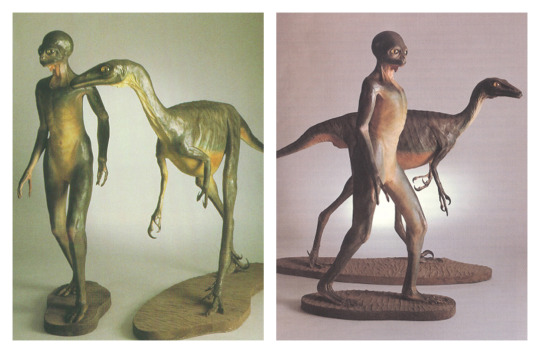
There are two highly-popular, vexing questions about dinosaurs: What would the world look like if these strange and majestic animals had not gone extinct? And, would they ever evolve into intelligent species comparable to humans? In 1982, palaeontologist Dale Russell, after observing “… a general trend toward larger relative brain size in terrestrial vertebrates through geologic time, and the energetic efficiency of an upright posture in slow-moving, bipedal animals”, postulated the Dinosauroid, a humanoid, erect-gaited sophont which may have evolved from Troodon-like dinosaurs had the end-Cretaceous extinction not occurred.

This question occupied the minds of yours truly (seen here on the right), and world-building comic genius Simon Roy (on the left), as well. We were unconvinced by Russell’s Dinosauroid. We thought that an erect, humanoid sophont was too prejudiced towards humans to be realistic. We were instead inspired by zoologist Darren Naish’s writings on the evolution of intelligent, bird-like dinosaurs: “No, post-Cretaceous maniraptorans wouldn’t end up looking like scaly tridactyl plantigrade humanoids with erect tailless bodies. They would be decked out with feathers and brightly coloured skin ornaments; have nice normal horizontal bodies and digitigrade feet; long, hard, powerful jaws; stride around on the savannah kicking the shit out of little mammals; and in the evenings they would stand together in the trees, booming out a duet of du du du-du, a deep noise that would reverberate for miles around…”
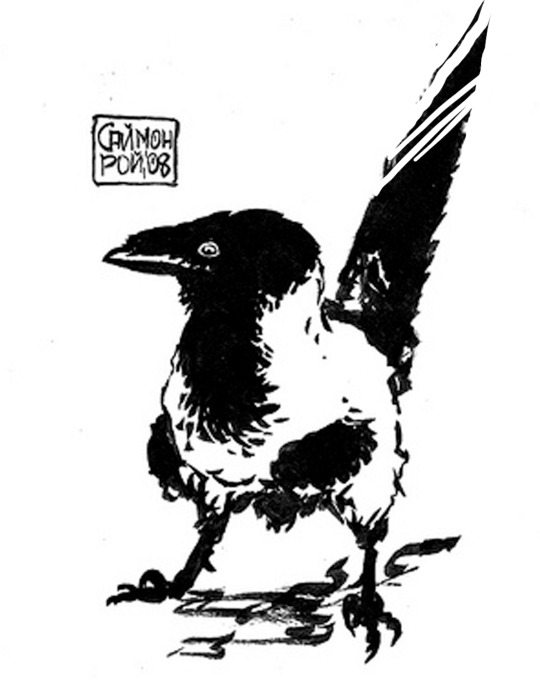
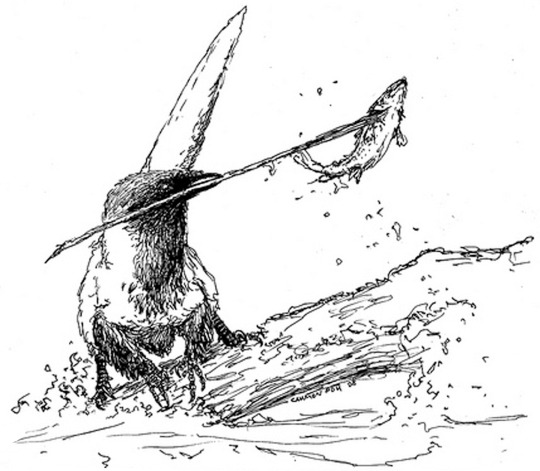
Towards the end of the ‘00s, Simon Roy and I independently began to develop our concepts for bird-like intelligent dinosaurs. Inspired by the ravens he saw around his Canadian home, Simon drew the corvid-like dinosauroids seen above.
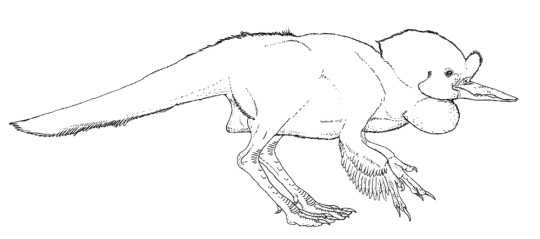
I, in turn, was inspired by ground hornbills, parrots, certain dinosaurs and corvids, and came up with the speculative organism seen above. I named it Avisapiens saurotheos.
Simon and I soon got in touch with each other; and started developing a world and a storyline for our dinosauroids. Our collaborative efforts continued, on-and-off, until the mid-2010s. Our aim was to develop the Dinosauroids story into an illustrated story-book, which we naively hoped to sell to a major sci-fi publisher. But we soon realised that we enjoyed world-building more than writing a story, or putting a book together. We kept bouncing concepts back and forth, but never had a chance to publish them, until now. Most of the body of work you see on this page was drawn by Simon, based on ideas we created together. I also contributed some of the “cave drawings” and certain creature illustrations. This is the first time the totality of our Dinosauroids-universe works has been displayed online.
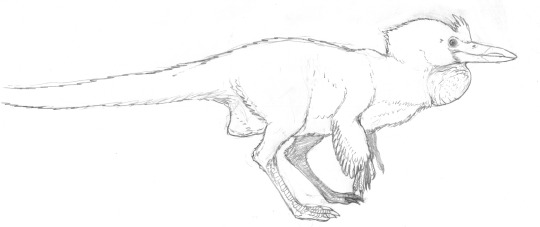
Simon and I refined the design of my original Avisapiens dinosauroid…
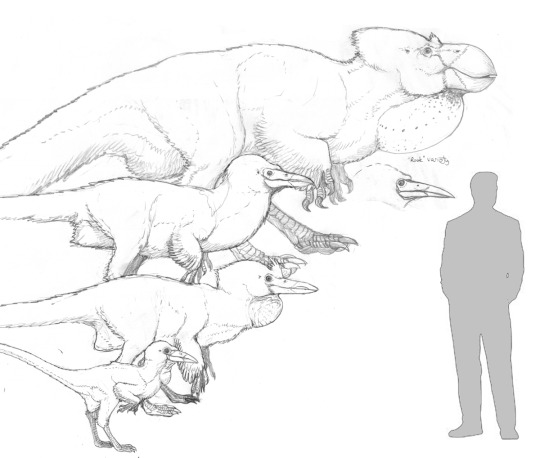
And created a few more sentient races to accompany them. There was one more, slightly-crow-like species of Avisapiens (a continuation of Simon’s corvid dinosauroids - Avisapiens tataricus). These two species were joined by a variety of “forest giants” (Gigantosapiens borealis), and a race of pygmies (Avisapiens minimus).
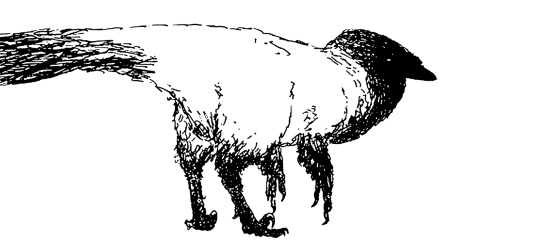
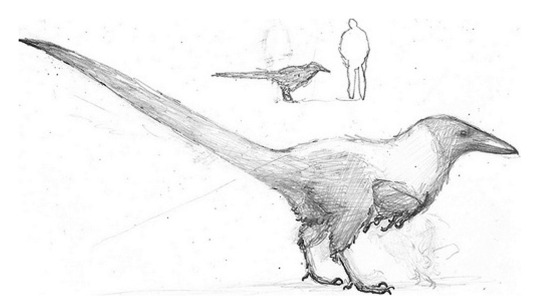

Simon’s refined studies of corvid-like, and pygmy dinosauroids.
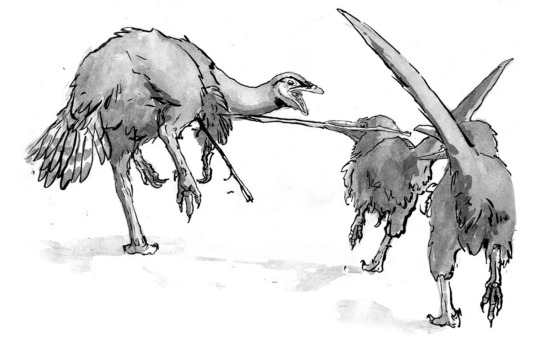
We also designed an extensive selection of animals around our dinosauroids. We predicted that even without the K/T mass extinction, dinosaurs and other animals would have kept on evolving, and many “familiar” groups of dinosaurs would have gone extinct. We thus designed a world where the majority of surviving dinosaurs were the descendants of “maniraptoran” groups; birds, deinonychosaur (“raptor”) dinosaurs, troodonts, oviraptors and therizinosaurs. Here, you can see two boreal dinosauroids using mouth-spears to hunt herbivorous troodont quarry.
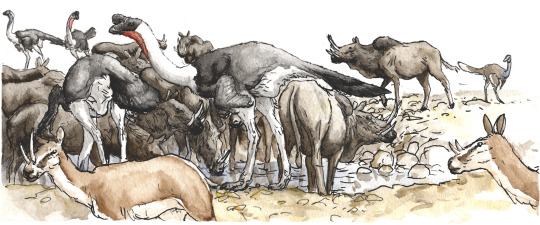
We also did not want this world to be devoid of mammals. Even during the age of dinosaurs, certain mammals evolved into large and sophisticated forms. We envisioned a world where parallel groups of mammals, similar to, but phylogenetically distinct from today’s forms, co-evolved alongside the dinosaurs during their continued reign. The scene above shows an Eurasian water-hole crowded with two species of ornithomimid herbivores (Rugocursor, left-centre; and Cyanogularia, far right); alongside robust (Afrotuberculocamelus) and gracile (Odontocervoides) species of herbivorous mammals which, for the lack of a better term, we decided to name “supermaras”.

A series of studies showing the evolution of supermaras from rodent-like multituberculate mammals. The species depicted here is Ceratomegamys.

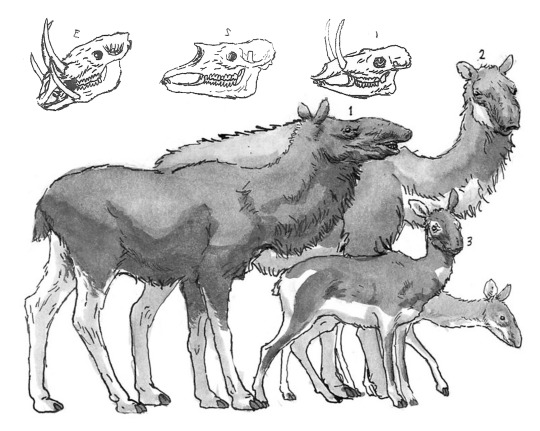
The full diversity of cursorial “supermaras”, from left to right: The burly, tusked Odontobovis; the superficially-camel-like Tuberculocamelus; the gazelle-like Odontocervoides; the trunked, moose-like Pseudalces; and the two related forms - the big, desert-dwelling Macropseudalces; and one of the many deer-like Cervopseudalces species.


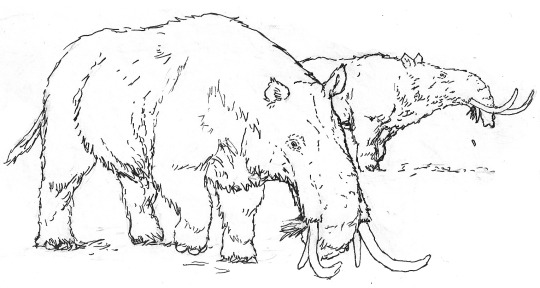
Studies of Megatapirus, large, superficially-elephant-like mammals that live in far-northern climates.


We also derived a variety of mammalian carnivores, mostly from marsupial stock. Through the honing forces of evolution, we imagined some would look very similar to the canid predators we have in the present day - the actual difference would only be in their internal and reproductive anatomies. Above, clockwise: The large, badger-like Mephitursoides; the extremely dog-like Pseudokynos; the hyena-like Krokutadasyurus.

Some marsupial predators diverged from the mammalian body-plan, and evolved into forms roughly converging with the predatory dinosaurs. The raptorial, meat-eating kangaroo-equivalent Theropodoktonos and kin are potent predators in South America.
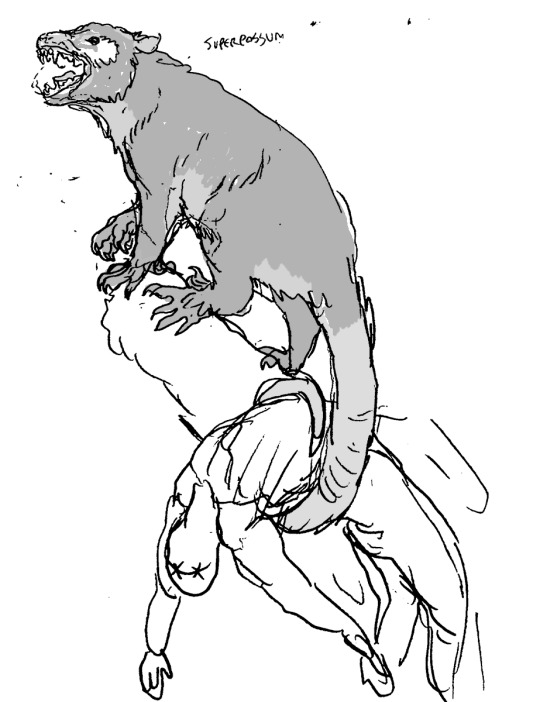

Two more divergent marsupials: The leopard/possum Phobodidelphyoides; and the monkey-like Marsupiolemuris, a social, arboreal form with a potential to evolve intelligence.

We also wanted to have flying reptiles - pterosaurs - still alive and kicking in our world. These extraordinary animals were already in decline by the time dinosaurs became extinct. So we relegated them to only a few roles, comparable to storks and other large water-birds alive today. Above is a flock of Diluvipterus; large, filter-feeding pterosaurs. Also note the solitary duck flying on the upper-left corner.
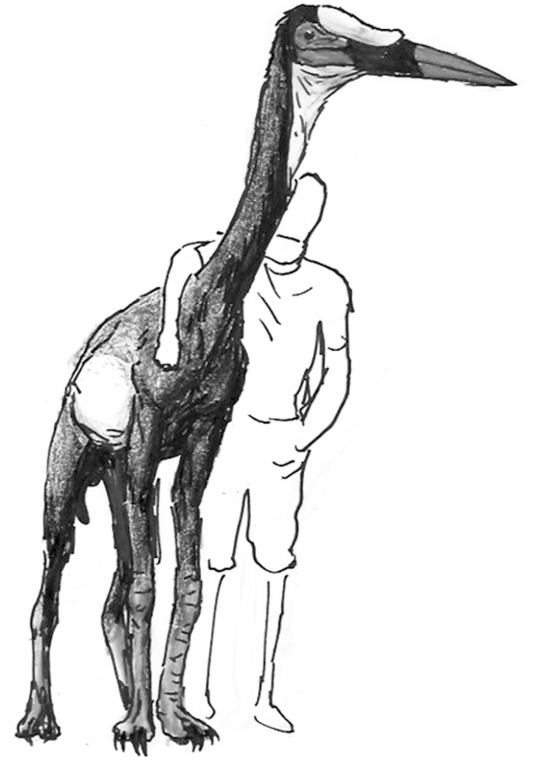
Another, flightless pterosaur, Cygnotherium, from the islands that now make up New Zealand.


A more unusual group are the avisuchians, descendants of maniraptoran dinosaurs that secondarily converged on the aquatic bodyplans of spinosaurs (which are now extinct in this timeline). Most resembled the short-tailed forms, Pisciraptor and Brachyornithoides seen above. These goose-to-dog-sized animals inhabit rivers and lakes, and occupied a niche comparable to otters today.

There were also long-tailed Avisuchians such as the Natatoraptor seen above. These animals inhabit open waters, and nested in estuaries and beaches.

A contemporary scene from Eurasia shows commensal life between mammals and dinosaurs. Two Pseudalces browse peacefully alongside two kinds of large ornithominids, Archganseria and Brontonyx. A tiny, heron-like troodont, Anatolocursor, can be seen between them, looking for small animals flushed out by the large herbivores’ movements.

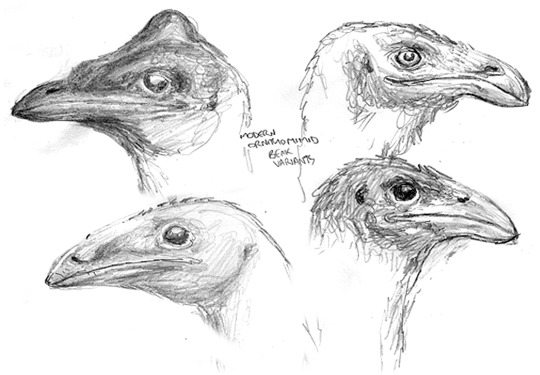
Nevertheless, despite co-existing with large mammals, dinosaurs are more diverse on this world. Herbivorous dinosaurs, such as these derived ornithomimids, constitute a large part of dinosaurian diversity. Above left are studies of Ganseria, a common, medium-sized browser. Above right, clockwise from the top right, are portraits of Ukkuloganser, another medium-sized browser; Nyctodromon, a nocturnal digger; Adzuganser, a small omnivore; and Pyramidoganser, a crested form native to the Nile Delta.

A scaled study of Brontonyx, a heavyweight ornithomimid herbivore.

Portraits of many cursorial dinosaurs from across Eurasia:
1- Leptoganseria, a mountain-dwelling ornithomimid browser found on the mountains of what is now the Caucaus.
2- Ikiridectes, a troodont that mostly hunts small digging mammals.
3- Aktardektes, a small ornithomimid that has specialised for cracking hard-shelled nuts.
4- The gracile, juvenile variant of Brontonyx, (6) which occupies a completely-different ecological niche as a generalist omnivore.
5- Rugocursor, a widespread, broad-beaked ornithomimid with many species, common across North Africa and Eurasia.
6- The adult form of Brontonyx, a gigantic ornithomimid that feeds on trees, and defends itself with heavy claws.
7- A vulture-like Cynornithoides, an extremely bird-like troodont, a frequent commensal of Avisapiens and related intelligent species.

A variety of Rugocursor, a mostly-herbivorous ornithomimid with adaptations for running.
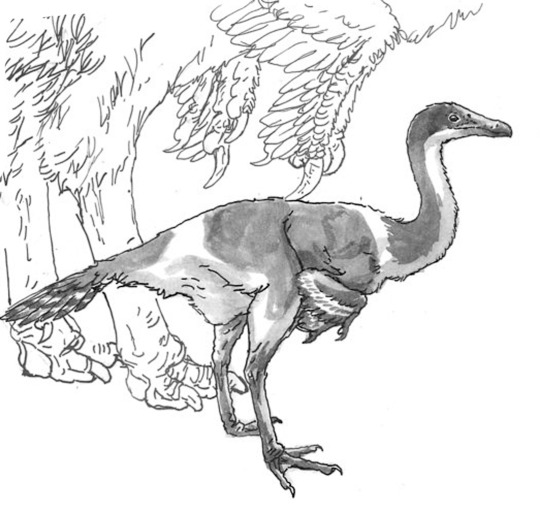
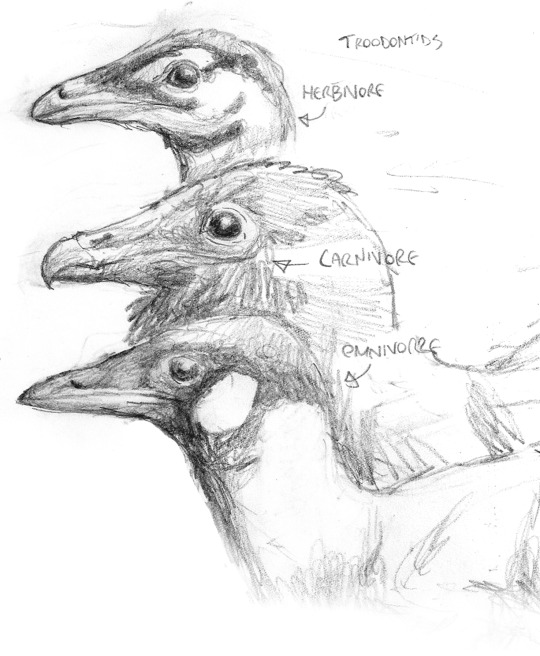
Various troodonts, small-bodied, sometimes very bird-like omnivorous dinosaurs, distantly related to the Avisapiens lineage. Left, shaded study of Variocursor, a common, heron-sized, striding predator on small animals. Right, from top to bottom; Vuuria, a herbivorous form common across Eurasia; Boreocursor, a cold-climate predator, related to the Variocursor seen on the left; and Paravuuria, an omnivorous form.


The last descendants of hadrosaurs, the famous “duck-billed dinosaurs”, still roam in South America. The hoofed, sheep-sized Ornimastax seen above left, is a typical example. Australia, as in our world, is home to an unusual radiation of forms whose relations to animals on other continents are not very clear. Brachygullagong, seen above right, is a troodont-like form whose duck-like skull and batteries of grinding cheek teeth have secondarily converged with those of the hadrosaurs.

The largest herbivores on this world are long-necked, scythe-clawed ornithomimid relatives known as avititans. The largest species on Eurasia is Avititan bicolor, seen above in scale with a human figure.
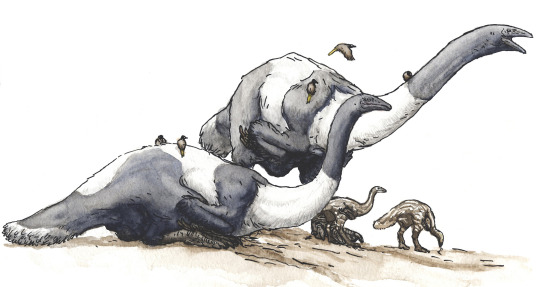
Avititans owe their ecological success to their strong social structures and their care of their young. Here are two Eurasian avititans with their offspring. Yellow-tailed enantiornithine tick-birds, Parasitophagus leucurus, can be seen on their backs.

Oviraptoriformes made up another important clade of dinosaurs in this world.

Descended from bird-like ancestors, various clades of these animals live on as important omnivores, scavengers and even predators in many ecological niches. Above is Eblisornis, a common species found throughout Eurasia.
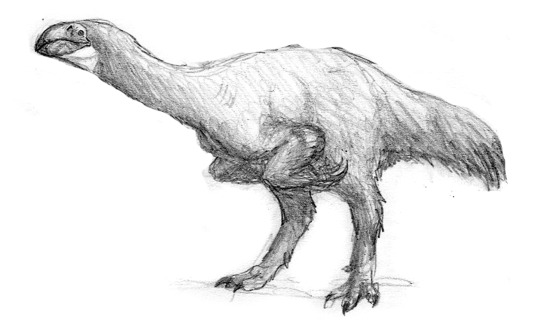
The bull-bird, Bosornithoides erythrops, is the largest and most prominent oviraptoriform on the Eurasian continent. It subsists mostly on plants and fruit, but will eat carrion if given the chance.
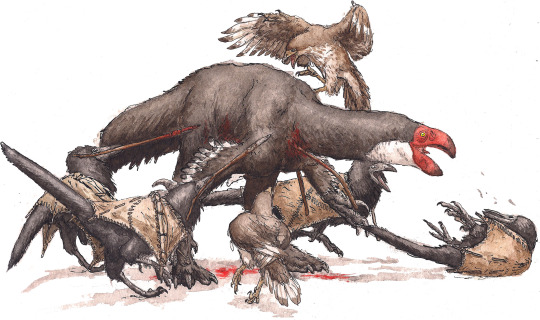
Hunting the wary and dangerous Bosornithoides is an important rite of passage for dinosauroids. The animals require coordination and group-work to bring down, and hunting one is a bonding experience for batches of young-adult nestmates. This ritual not only cements the dinosauroids’ social standing in their tribe, but also bonds the hunters together for the rest of their lives. The four hunters-to-be in this picture are accompanied by a couple of jackal-birds (Cynornithoides), domesticated pets that are almost as smart as the dinosauroids themselves.
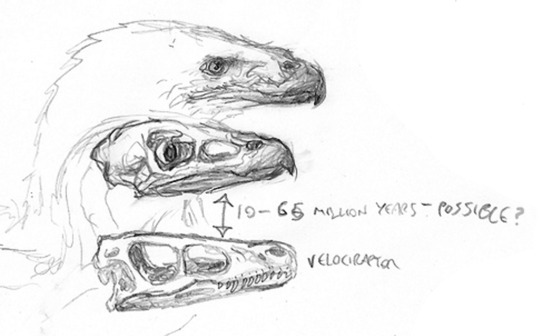
Many dinosaurs dabble in carnivory, but the main predatory niches on this version of Earth, are occupied by a diverse radiation of paradromaeosaurs, descendants of the famous “raptor” dinosaurs and kin. Paradromaeosaurs have diverged considerably from their ancestors. One lineage, known as the rhynchovenators, replaced their teeth with sharp, raptorial beaks.
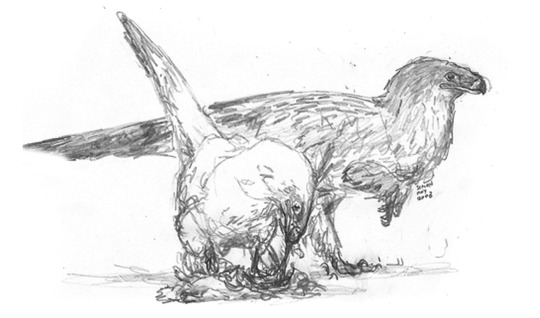
The male and female of the common boreal rhynchovenator, Rhynchovulpes agilis.

A lean-legged Egyptian rhynchovenator, Rhnychovulpes aegypticus, atop a dead multituberculate mammal. The key to rhnychovenators’ success is their added tenacity and stamina. Even a small rhynchovenator can overcome comparatively large prey by continually harassing and chasing it into exhaustion.

The bald-headed Osteophaganax regalis is a common scavenger encountered across the Caucaus Mountains. Its males develop striking, black-and-purple wattles on their faces during spring.
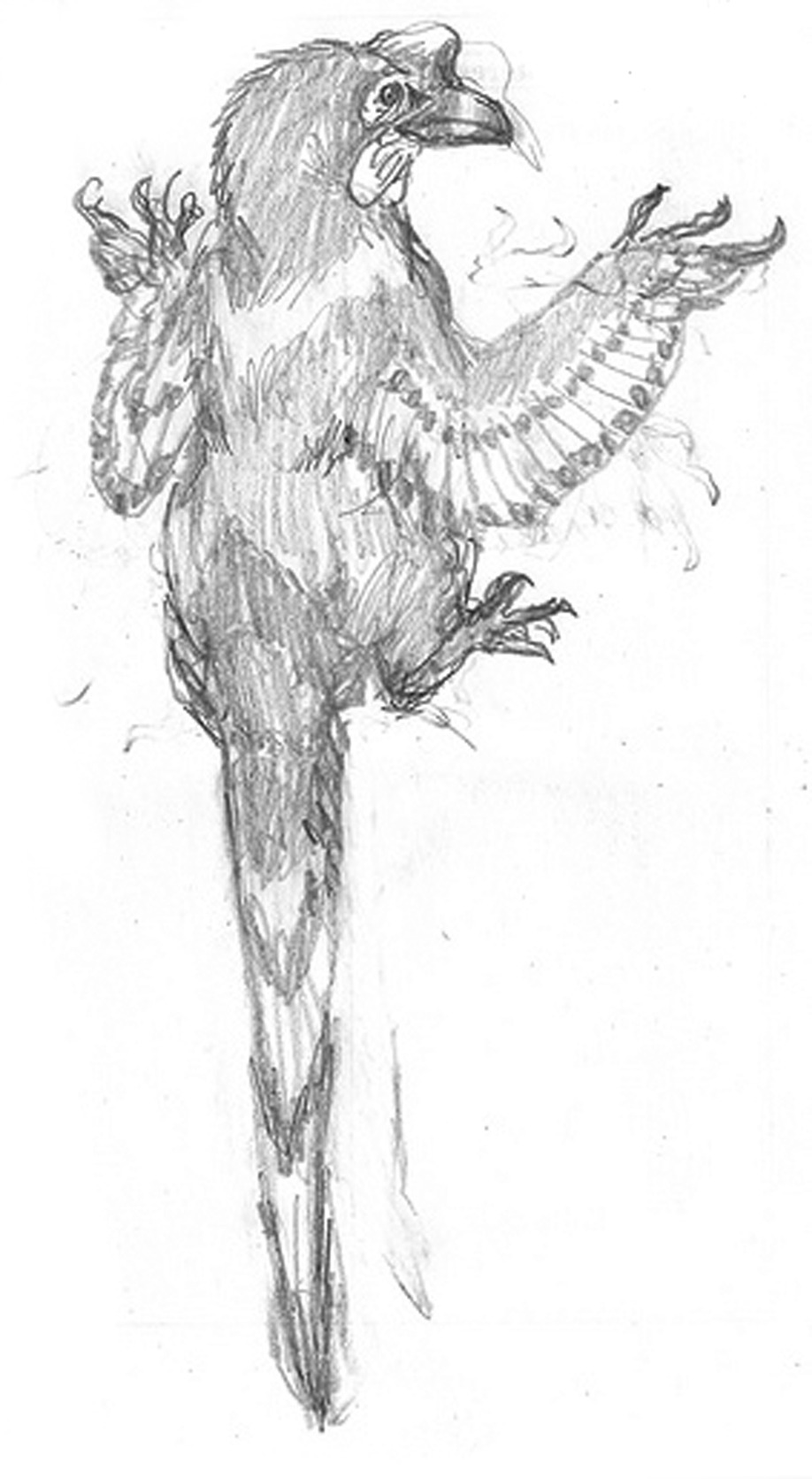

Two more derived troodonts. Left, a tree-dwelling arbosaur, Toucanops dixoni, from one of the diverse and little-understood clades found across the South American continent. Right, the lean, narrow-beaked Halophagus sp. from fossil deposits in what is now China. This group evolved specialisations for marine diving and probably saltwater drinking, before becoming extinct during the Miocene.
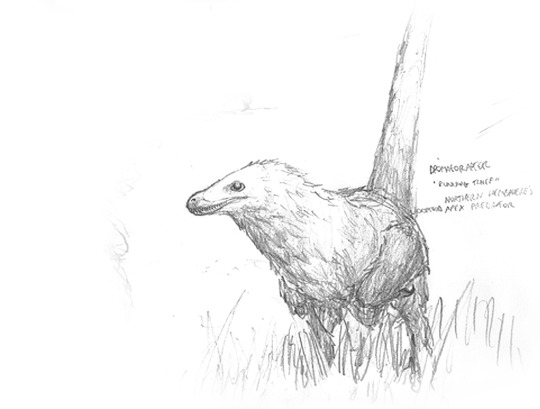
The dominant guild of maniraptoran predators, the tyrannoraptors, evolved from “regular” dromaeosaurs with powerful, biting jaws. Some species living today, such as the Savannahdromeus shown above, are still very similar to the earliest forms. Despite its small size, the smart and social Savannahdromeus are apex predators thanks to their pack-hunting behaviour.

Another basal tyrannoraptor, Pantherdromeus - is a solitary hunter that is common across much of Eurasia. It probably represents a diverse and subtly-variable species complex.

Solitary, basal tyrannoraptors eventually gave rise to the terrifying main-line tyrannoraptors in the last twenty-million years. The evolution of these animals was marked by the reduction of their wings and the enlargement of their legs, and jaws. Their tails developed into stiff and rod-like balancing organs. In some respects, they were the evolutionary echoes of the big-jawed, running tyrannosaurs, which had become extinct earlier on, during this world’s version of the Eocene period. Unlike tyrannosaurs, however, tyrannoraptors had well-developed social behaviours and intelligence; which, when coupled with their fast speed and terrific jaws, turned them into formidable apex predators. Above are the adolescent and mature forms of Metadromodaemon phobetor, a mid-sized hunter found in the Middle East and North Africa.
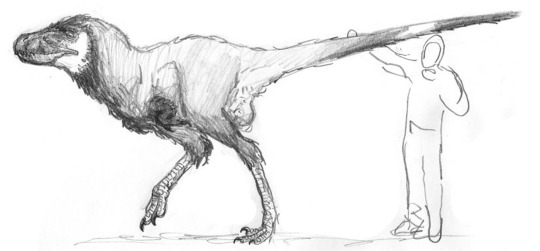
A scaled drawing of Wotandromeus bicolor, the terrifying, large-headed hunter of European forests.
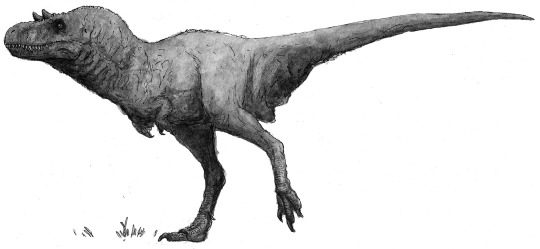
The seven-metre-long Melanorodromeus euceratus - also known by the Dinosauroids as “black thing” - is the largest predator on mainland Eurasia; but even larger forms are reputed to exist in Siberia and North America.

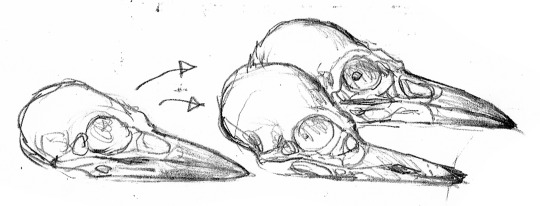
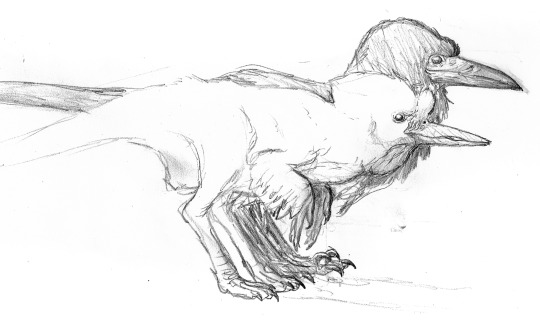
Let us now return to the Dinosauroids, their culture, and art. Above is a brief study illustrating the divergence of the two species of Avisapiens; A. saurotheos and A. tataricus, from ancestral eu-troodontid stock.


Especially A. tataricus shows considerable variation in beak shape, length and colouration. Above, right are the colouration of the Eurasian (top right, bluish-black), and Northeast Siberian (above right, yellowish-brown) races. Above, left shows a spectrum of variation in A. tataricus beaks. The cross-beaked and long, curved beaks occasionally crop up in certain bloodlines, which also have augmented song-memories. These individuals are revered as shamans in certain A. tataricus tribes; or are immediately killed-off as harbingers of doom in others.
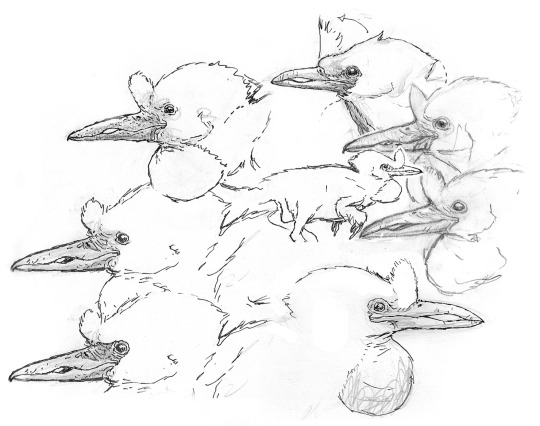
Above, the extensive variation in the head shapes, beak lengths and crests of various races in A. saurotheos. The bottom-right sketch depicts a hybrid individual between A. saurotheos and A. tataricus.

A powerful hunter of A. tataricus, from the Carpathian Mountains, showing a stone axe and bent spear that are characteristically used by this particular tribe.
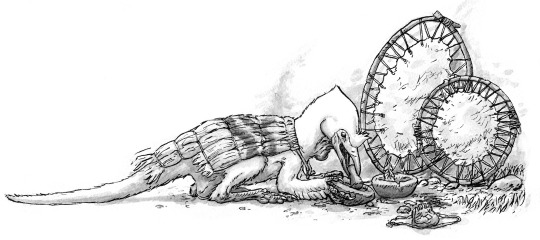
An artist/shaman of one of the settled A. saurotheos tribes living around the Balkans. He paints on animal skins stretched taut across circular frames, and paints using ground-up soil and other pigments, wielding a brush made from a wing-feather. The skin canvas also double as drums.
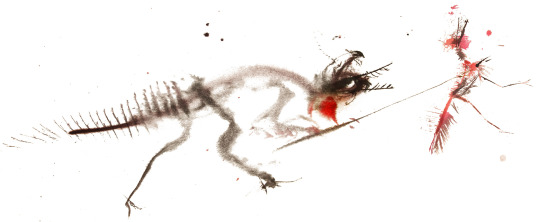
Art is one sure-fire way of identifying an intelligent species. This skin-painting shows a spear-hunter and prey, a painting by the aforementioned shaman.

Painting of a god or hero-figure with red tail feathers.
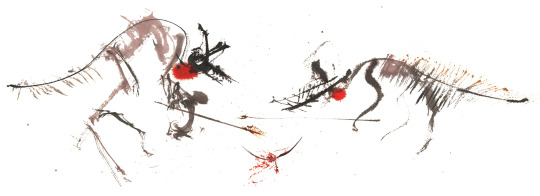
Painting of two shamans divining the future from the entrails of a dead flying animal.
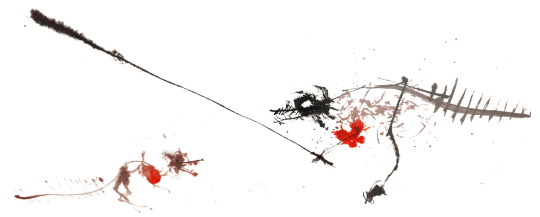
Painting of a hatchling being trained by a village elder.
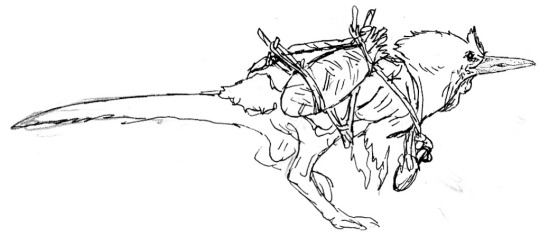

Studies of an A. saurotheos wanderer with a travel harness; and a duo of A. tataricus migrants with a domesticated bull-bird, a relative of the oviraptoriform Bosornithoides mentioned above.
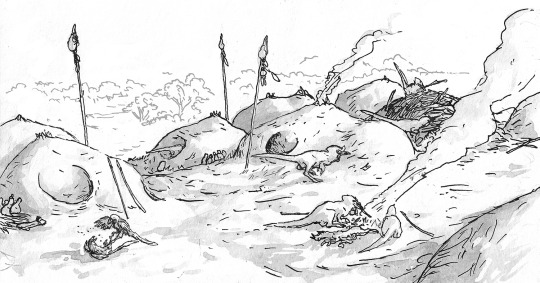
The view from an Avisapiens saurotheos village, showing the species’ characteristic nest-houses, and a pair of semidomesticated Cynornithoides jackal-birds playing in the village square. Note the heads mounted on tall poles, a sign of reverence to the spirits of the departed.
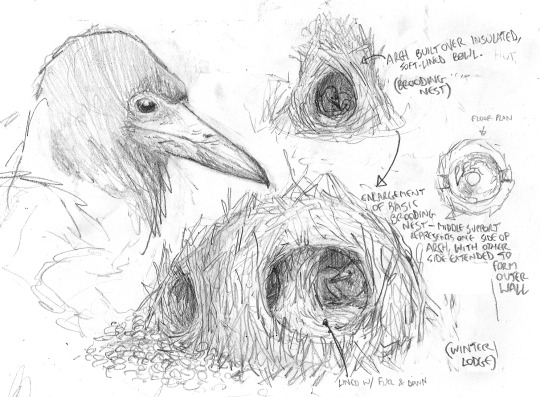
Detail of a brooding nest constructed by Avisapiens tataricus. Most tribes of these species are migrants that range across Eurasia, few build permanent structures.

Sketch of an A. tataricus wearing a travois-like travel harness.

Study of an A. saurotheos wanderer with travel gear.
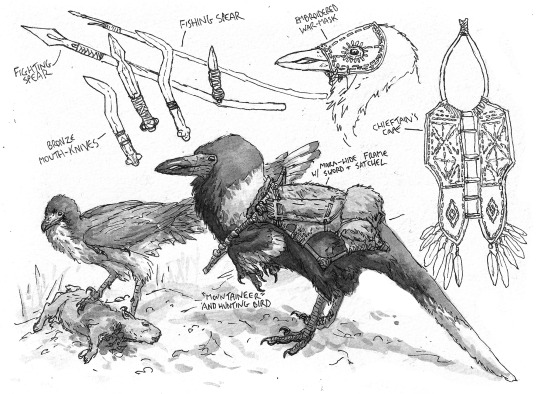
A detailed study of the burly A. tataricus native to the Caucaus Mountains, complete with weapons, travel gear and ornamental cape.

Sketches of war-like A. tataricus tribes native to the Eastern Mediterranean region. These tribes are known for their ferocious (if impractical) war-masks.
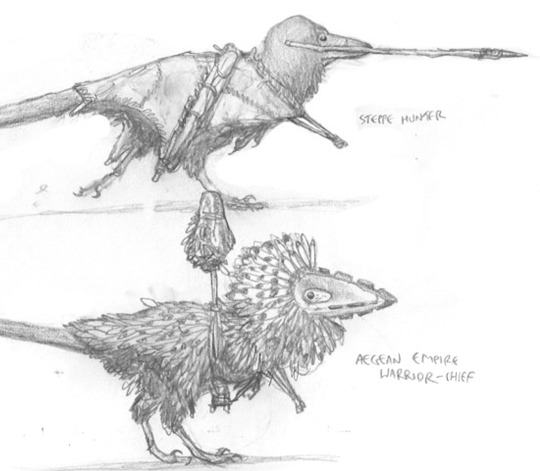
Studies of two different warriors from two different Avisapiens tataricus societies.
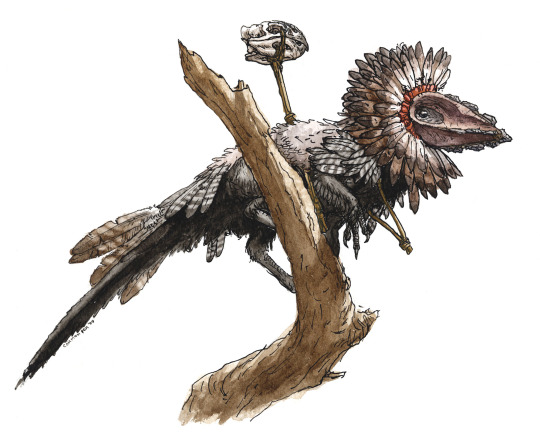
A resplendent A. tataricus warrior from the Levant, wearing an ornate head-dress of feathers, and an obsidian-studded war-mask.

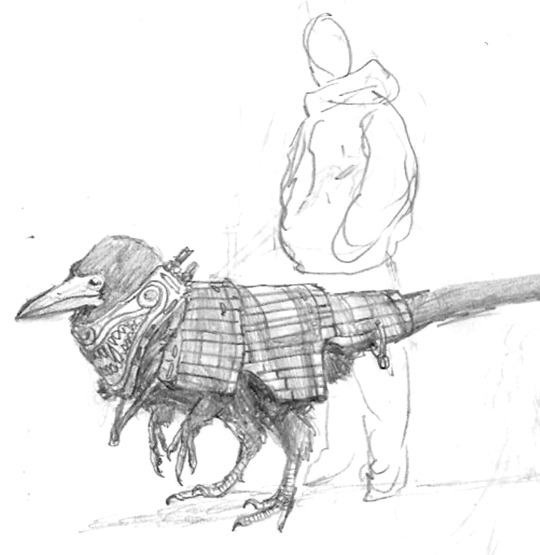
Studies for Avisapiens spear-throwers and wooden-slat armour; from a comparatively advanced period on this species’ societal development.

An A. saurotheos shaman entertains hatchlings with fireside tales of spirits and other worlds.

A band of slave-keeping A. tataricus warriors during a raid to an A. saurotheos village. A young shaman is captured and de-clawed.

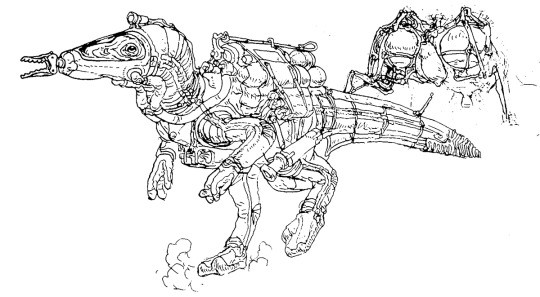
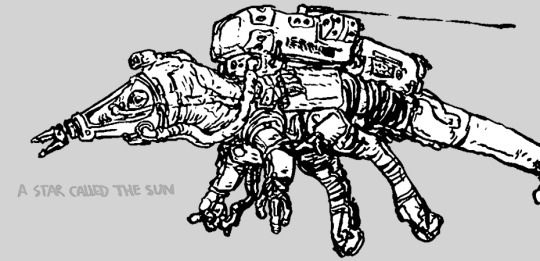
Simon Roy and I also dwelled on the far-future evolution of dinosauroid technology. The sketches above of a “knight”, moon lander and an astronaut were produced, but we did not pursue these scenarios seriously.

Let us conclude our visit to the dinosauroid tangent-universe with one last look at our artist/shaman, his village, and his paintings. Somewhere in deep time, they are still alive, and still waiting to tell us of their adventures.
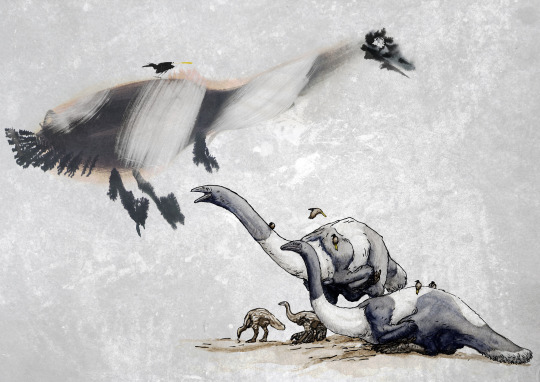
A painting of an avititan family.

A painting of the dangerous, predatory “black thing”.
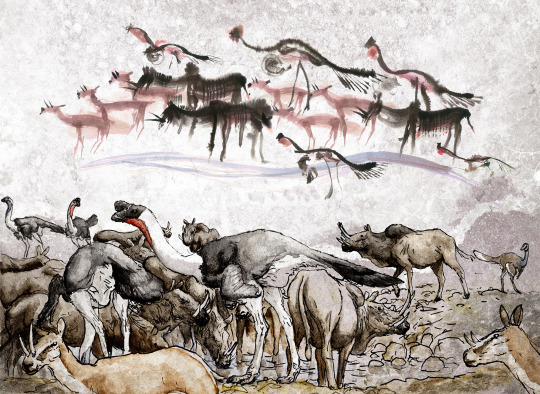
A painting showing numerous animals at a watering hole.

A painting showing an A. tataricus warrior.
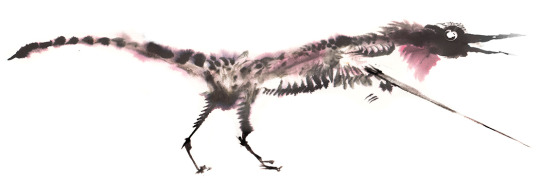

Stylised paintings of spear-wielding Carpathian warriors.

Painting of a ferocious Aegean headhunter.

A stylised painting showing an immature dinosauroid.
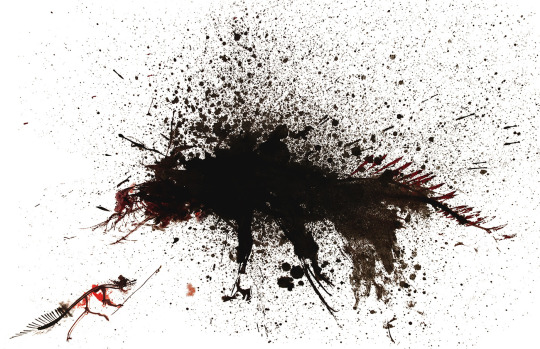
Stylised painting of a warrior confronting a spirit-creature.

Stylised painting of a powerful Caucausian mountain warrior.

Painting showing a ghoul-like oviraptoriform animal.

Painting of one of the sky-gods worshipped by A. saurotheos.
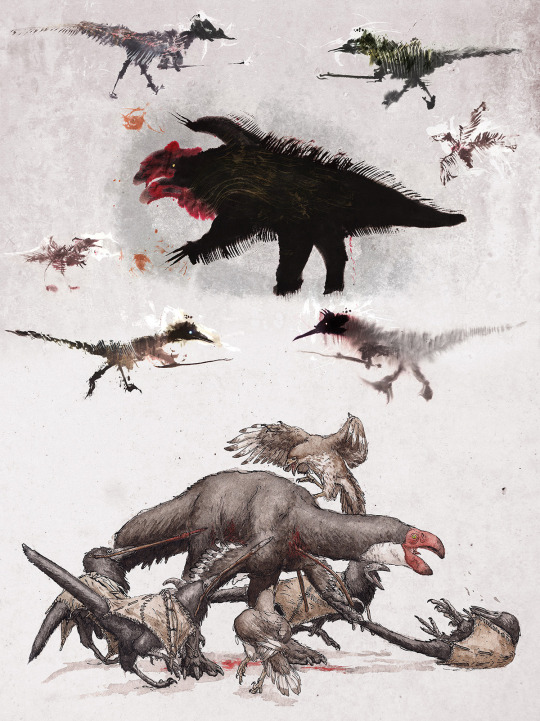
A complex painting showing four A. tataricus warriors hunting a bull Bosornithoides.
Simon Roy and I may return to the dinosauroids universe one day with a real story; but truth be told we enjoyed world-building far more than inventing stories and characters.
- 2008 - 10/2019.
#worldbuilding#speculative biology#speculative evolution#dinosaurs#dinosaur art#dinosauroids#paleoart#creature design#c m kosemen#simon roy
431 notes
·
View notes
Photo


#spinosauridae#spinosaurus#geology#dinosaur#paleontology#reptile#animal#bones#fossils#spine#the earth story#sail#fossilfriday
121 notes
·
View notes
Text
A Journey to France to Uncover the Mysteries of the Carnegie’s Grand Staircase
The Carnegie Institute has been in existence for 125 years and is one of the greatest architectural buildings ever designed in Pittsburgh. In 1985, Carnegie Institute President Robert Wilburn invited Dr. Cynthia R. Field, the Smithsonian’s Architecture Historian, to assess the artistic value of the museum. He asked, “what do you think is the most valuable specimen or painting in the museum?” She said, “The Building Itself is the Greatest Object of the entire Museum Collection” (Fig. 1).

Fig. 1: Carnegie plaque
The internationally-famous architect, I.M. Pei, who designed the Louvre’s glass pyramid that sits in the Louvre’s central courtyard in Paris, France, opined, “Architecture is the very mirror of life. You only have to cast your eyes on buildings to feel the presence of the past, the spirit of a place; they are the reflection of society.” In 2018, Architecture Digest ranked the Carnegie’s Grand Staircase the 8th best museum staircase in the world. The Grand Staircase was built by the Pittsburgh architectural firm of Alden and Harlow at the apex of America’s Gilded-Age building boom. During my research, I discovered that the architects employed multicolored classic marbles and fossil limestones in the interior design from Algeria, Croatia, Greece, France, Ireland, Italy, and the United States. The commission to build the Grand Staircase in 1907 incorporated two classical French fossil limestones in the columns and pillars, floor tiles, steps, walls, balconies, and water fountains. This monumental Beaux-Arts style staircase is modeled after the L‘Opéra Garnier ‛a Paris, Grand Staircase in France, c. 1875, and was visited by a French Delegation with Andrew Carnegie (Fig. 2). The architecture described as Beaux-Arts was taught at the École des Beaux-Arts in Paris, from the mid-19th century until 1900. It drew upon the principles of French neoclassicism and used modern building materials, i.e., iron and glass. And as such, it became a preferred architectural style in the United States from 1895 until 1910 in cities such as, Boston, Chicago, New York City, Pittsburgh, and Washington D.C.

Fig. 2: French delegation and Andrew Carnegie
In 2019, The Carnegie’s Grand Staircase and Music Hall Foyer were recognized in the book La pierre de l’Échaillon Une histoire locale, une renommée international for the use of Échaillon jaune (yellow) ornamental stone in the museum’s columns, pillars, and walls (Fig. 3). This book was published by S.P.I.A. (Sauvegarde du Partrimoine Industriel d’Autrefois, a historical society founded by Jean Paul Rey, president) (Fig. 4). In the book, they describe how a small French village of l’Échaillon, pronounced Esh-ee-own, received recognition for its white marble (a limestone) used by famous French architects in 64 classic buildings and sculptures from 1875 to the early 20th century (Fig. 5). I first met Jean Paul in October of 2016, when I was invited to give a presentation at an S.P.I.A. meeting on my research on the Carnegie’s l’Échaillon. The meeting was held in an old schoolhouse in the village of Saint-Quentin-sur-Isère, Département de Isère, in southeast France.
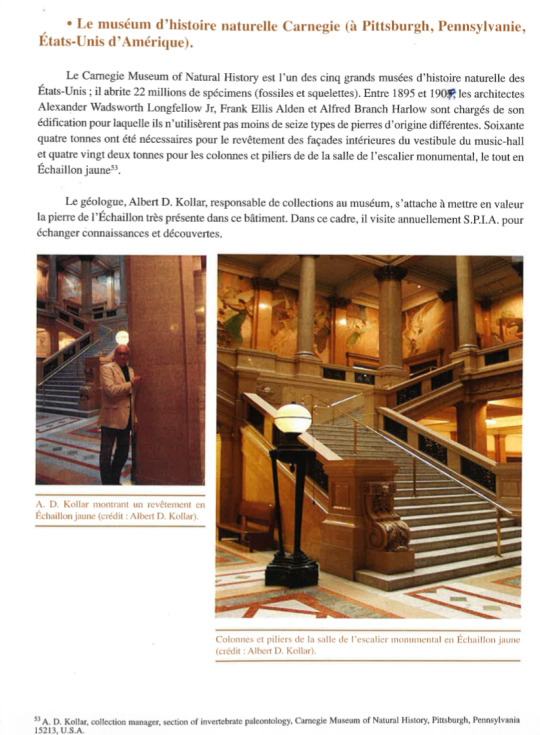
Fig. 3: The Grand Staircase

Fig. 4: Jean Paul Rey and Albert D. Kollar

Fig. 5: Book cover
The French Limestones in the Carnegie’s Architecture
The Carnegie building stones research project progressed significantly, once we obtained the digital images of the architect’s blueprints from the Carnegie Museum of Art’s Architecture Department. With the assistance of my co-authors, Rich Fedosick and Kay Hughes of the Section of Invertebrate Paleontology, we examined the blueprints to understand the architects Marble Index terminology (Fig. 6). Eventually, we were able to interpret and recognize the location of the two French limestones based on the Marble Index letters, E for Échaillon and H for Hauteville. From a nonscientific perspective, the architects considered the Carnegie’s interior stones to be marbles. However, the geological definition of a marble is when a rock defined as a limestone or dolomite is subjected to high heat and pressure from geologic forces forms a metamorphic rock. The six stones listed in the Marble Index as marbles, are limestones, a sedimentary rock enriched with fossil seashells. The characteristic rudist fossils and yellow color that distinguish the Échaillon stone are found in the 18 pillars and the 22 columns that rise 3.8 meters or 12.5 feet about the Grand Staircase, and in the walls of the Music Hall Foyer (Fig. 7).
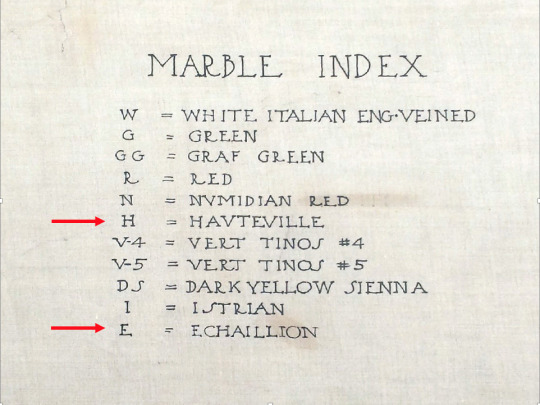
Fig. 6: Marble index E and H letters

Fig. 7: Échaillon fossils
The other French limestone used in the Carnegie is Hauteville. This limestone was quarried from the Plateau d’Hauteville in the Ain Department, in eastern France. I visited this quarry in 2016 to investigate the geology of the quarry operation, to uncover evidence of the common fossil snail Nerinea in the quarry rock (Fig. 8), and to learn more about the cultural history of the region (Fig. 9). The Hauteville limestone was used in the Grand Staircase walls, balcony features, water fountains, vestibule steps, and as floor tiles. Other locations include, the Hall of Sculpture and Hall of Architecture floors, the walls along the grand hallway, the Music Hall vestibule floor, the Founder’s Room vestibule floor, the floor and steps in the Smoking Room (now offices), the Forbes Avenue vestibule entrances to the music hall, carriage drive, and museum and fine arts. Moreover, the Hauteville floor tiles are distributed throughout the Carnegie Library of Pittsburgh main entrance corridors. The Hauteville stone is beige in color and contains many visible fossils, none more distinctive than the robust Nerinea, a 12.7 cm/5-inch-long snail that serves as the index fossil for the limestone identification (Fig. 10).

Fig. 8: Hauteville Quarry fossil snail

Fig. 9: Hauteville directional signs

Fig. 10: Nerinea snail in Carnegie floor
Introduction to the l’Échaillon Carrières
There are three carrières or quarries in the Vercors cliffs located in the Isère River Valley that were excavated for White Echaillon or “Echaillon blanc,” Yellow Echaillon or “Echaillon jaune,” and Pink Echaillon or “Echaillon rose” during the 19th and early 20th century (Fig. 11). These unique color combinations became popular for various interior and exterior architecture features in 194 buildings in western Europe, North Africa, and the United States. In 2016, Jean Paul Rey and members of S.P.I.A. led me on a field trip to the abandoned classic l’Échaillon white quarries (Fig. 12). We explored what is thought to be a 2,000-year-old Roman quarry and walked through a maze of underground caverns and narrow tunnels that contained abandoned mining equipment. The other two Echaillon carrières are located several kilometers south in the small villages of Lignet, where the Pink Echaillon was quarried (Fig. 13) and Rovon, where the Yellow Echaillon was excavated (Fig. 14).
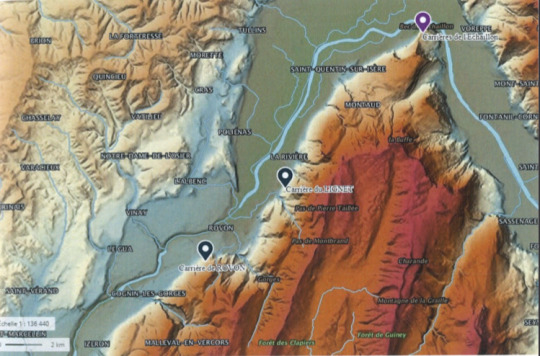
Fig. 11: Echaillon quarries locations, S.P.I.A.

Fig. 12: Visit to Echaillon

Fig. 13: Lignet Quarry Marker

Fig. 14: Rovon quarry
Cularo, Grenoble, and the white l’Echaillon stone
A fortuitous discovery was made by S.P.I.A. for their book while searching for evidence of the white l’Echaillon in the Gallo-Romans era 4th century Cularo or Grenoble, France today. In the Saint Laurent crypt that is preserved many meters below the modern-day street level tramway, a white capitol on top of a white limestone column was identified as l’Echaillon. This white capitol stone is presumably from the Roman quarry adjacent to the white l’Echaillon underground caverns. When Emperor Gratian ruled the Roman Empire from 367 to 383 A.D., he renamed Cularo after himself. Cularo thus became Gratianopolis, which through a later phonetic shift became Graignovol and then Grenoble. Although hard to find among the narrow streets and passageways of Grenoble, is a section of a Roman wall that once encircled Cularo, a portion of which is protected by a fence. This historic wall can be seen at Passage Sainte-Claire on the corner of Rue Lafayette, in the central city of Grenoble (Fig. 15). I suspect some of the white cobbles embedded in the wall may have their origin from the white l’Echaillon Roman quarry. Undoubtedly, more research will be necessary to make an affirmative conclusion.

Fig. 15: Roman wall
“Geology of the l’Échaillon Carrières”
The drawing of a new geologic map on the l’Echaillon carrières by Professor Thierry Dumont of the Université Grenoble-Alpes, confirms stratigraphically, the ages of the three limestone quarries. Among the three, the white Echaillon limestone is late Jurassic in age, whereas the pink Lignet and yellow Rovon limestones are early Cretaceous in age. The formal geologic name for the rose and yellow limestones is the Urgonian Formation. Fossils are abundant in the three limestones. Dr. Claudie Durand of Le musèum d’Histoire naturelle de Grenoble (Fig. 16) curated a diverse collection of 163 species of invertebrate fossils from l’Echaillon first published in 1919. Geologically, the three limestones were deposited in the tropical Tethys Seaway a circum-equatorial ocean of the Mesozoic Era. The strata form the Vercors carbonate platform, a buildup of late Mesozoic rudist (bivalve mollusk) reefs spanning 25 million years of evolution from (late Jurassic 140 million years ago to early Cretaceous 165 million years ago) (Fig. 17).

Fig. 16: Dr. Claudie Durand

Fig. 17: Rudist (bivalve) reef fossils
The Rovon carrière provenance and fossils
The primary goal of this research is to define the geology and authenticate the specific provenance of all marbles, fossil limestones, sandstones, and the singular igneous granite rock used in the Carnegie building. The search for the provenance of the Carnegie’s yellow Echaillon was initiated in December of 2017 by Jean Paul Rey, when we were introduced to the Forman of the modern-day Rovon quarry. After a long discussion about our objectives, he granted permission to visit the old quarry. As darkness fell, we met with a local farmer who directed us to the quarry location in the Vercors cliffs that rise some 538 meters above his snow-covered field (Fig. 18).

Fig. 18: Verors cliffs and old Rovon quarry
In October of 2018, the S.P.I.A. team pre-arranged to have several 4-wheel trucks transport ten people including Professor Fabienne Giraud-Guillot of the Université Grenoble-Alpes to the Rovon quarry. We ascended the long steep road that ended some 500 m from the main quarry. Surprisingly, the quarry was filled with massive limestone boulders that were cut by mechanical wire saws from the cliff rock (Fig. 19). Such large boulders make it virtually impossible to break with small hammers. For actual fossil collecting purposes, it is better to search for smaller size rocks to break apart (Fig. 20). This past October, transport to the Rovon quarry riding in a 55-year-old Russian built farm tractor was a treat (Fig. 21). And the fossil collecting was a success with 21 complete specimens collected for the museum of the diagnostic Caprina rudist bivalve clam (Fig. 22). The shape of these fossils closely resembles the fossils preserved in the Echaillon limestone in the Grand Staircase and Music Hall Foyer. Additional geologic data is being reviewed by colleagues from the Geology Department at the University of Zagreb in Croatia and the University of Ireland at Galway.

Fig. 19: S.P.I.A. team

Fig. 20: Collecting fossils

Fig. 21: Russian tractor

Fig. 22: Caprina rudist clam
“Carnegie’s Grand Staircase in the 21st Century”
A study published this month by the BMJ, formerly The British Medical Journal, suggested that “when people of all ages participate in the arts and visit museums once a month or even every few months, they are likely to be more engaged in the world and may actually live longer.” Years ago, the Oscar winner actor Russell Crowe was in Pittsburgh, and he was asked what he did on his days off. In reply, he said, “I ride my bicycle to look at buildings and the architecture of the city.” I. M. Pei states, “Architecture brings people together.” I agree.
Maybe it’s time to reconsider how the Carnegie’s Grand Staircase is promoted to the public at large. For instance, the current arrangement of the free-standing dioramas situated on the first floor, awkwardly impede the flow of patrons walking among the pillars, columns, and the taking of photographs of the Grand Staircase. Moreover, the placement of these dioramas detracts from the visual enjoyment of the famous John White Alexander multicolor murals. An artistic feature of the murals is their connection to the stone colors to enhance the first and second floors architectural features. The best vantage points to see this fabulous spectrum of color is from the third-floor balcony looking down to the first and second floors.
The Carnegie Museum of Art (Museum of Fine Arts) will be celebrating its 125th Anniversary in the fall of 2020. The Grand Staircase was designed as the showcase entrance to the Museum of Fine Arts for Pittsburghers of the early 20th Century. One hundred and twenty-five years later, perhaps, this world-class space can once again establish a new generation of museum patrons and become the destination as a place to be for its cultural and intellectual heritage. And don’t forget, this staircase can be an Instagram-worthy site for a family portrait to encourage our younger audiences to visit too.
Albert D. Kollar is the Collection Manager in the Section of Invertebrate Paleontology at Carnegie Museum of Natural History. Museum employees are encouraged to blog about their unique experiences and knowledge gained from working at the museum.
88 notes
·
View notes
Text
Irritator challengeri
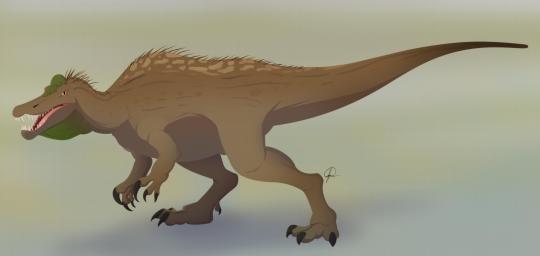
By José Carlos Cortés
Etymology: The One That Irritated
First Described By: Martill et al., 1996
Classification: Dinosauromorpha, Dinosauriformes, Dracohors, Dinosauria, Saurischia, Eusaurischia, Theropoda, Neotheropoda, Averostra, Tetanurae, Orionides, Megalosauroidea, Megalosauria, Spinosauridae, Spinosaurinae
Status: Extinct
Time and Place: Between 110 and 108 million years ago, in the Albian of the Early Cretaceous

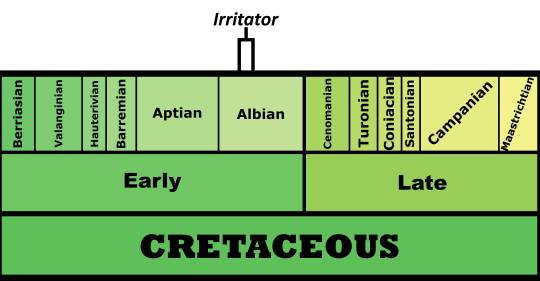
Irritator is known from the Romualdo Member of the Santana Formation in Brazil

Physical Description: Irritator was a Spinosaurid, so the weird crocodile-mimicking theropods that roamed the Cretaceous landscape across the Southern hemisphere (and some of Europe). Irritator, however, is not known from very much material, despite having loads written about it. It was one of the smaller members of the Spinosaur group, only about 7.5 meters long and not weigh more than one tonne - which may actually indicate it could have still had some sort of fluffy integument, though this still seems unlikely based on its ecology. As a Spinosaur, Irritator would have been fairly bulky, with a long and vaguely crocodilian skull. Its skull also featured a long thin crest going from the midline to the eye, where it flattened into a bulge - this was probably some sort of display structure. Little is known of the rest of its skeleton, but it is known to have had a long and well-clawed hand. It probably had some sort of sail on its back, but it probably was a shorter one, and whether or not its legs were a normal size is unknown.

By Alexander Vieira, CC BY-SA 4.0 (Irritator is on the far right, in green)
Diet: Irritator would have mainly fed upon fish and other aquatic organisms.
Behavior: Irritator, being a Spinosaur, spent most of its time in the water, swimming about and searching for food. Since it was rather small, it would have been able to fit in smaller streams of water than most of its other relatives. Though, since it probably still had fairly decent legs, it also would have spent a good amount of time on the land, surveying the shore for food and seeking out prey. Its long snout would then be used to grab fish and other animals from the water, using the lightweight instrument to grab food it might not be able to reach otherwise. While swimming, it would be able to use that snout to reach even more food than before, ducking its head underwater or doing the reverse to hide from land sources of prey. Its very powerful neck muscles would have also been extremely helpful in grabbing and holding onto thrashing prey.

By Fred Wierum, CC BY 3.0
Irritator was probably warm-blooded, and used its sail more for display than for keeping warm. This display structure may have been able to change color based on blood circulation or environment in order to send different messages to other members of the species. The crest on the center of the snout also probably served similar features, for displaying to one another. It seems likely that Irritator, like most other dinosaurs, took care of its young; but there is no evidence either way to support that hypothesis.
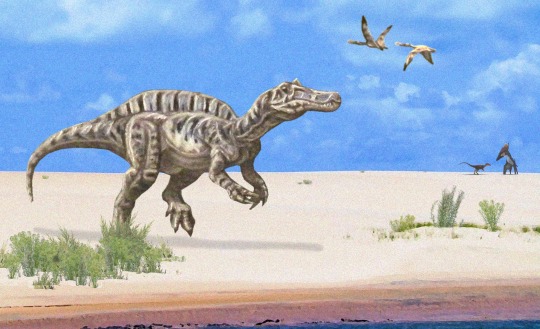
By PaleoGeekSquared, CC BY 3.0
Ecosystem: Irritator lived in the Romualdo Environment of Brazil, which was a basin of lakes surrounded by rivers and other wetland environments, filled to the brim with a wide variety of plantlife. Nearby was the burgeoning Atlantic Ocean, making this a Spinosaur’s favorite place of all. Here there were a wide variety of early flowering plants like magnolias, seagrasses, and lilies - all of which were associated heavily with this aquatic environment. There were many types of ray-finned fish, which would have been the primary source of prey for Irritator, as well as lobe-finned fish which would have also been decent sources of food. Sharks seem to have been rare. There were plenty of turtles too, including one of the earliest sea turtles Santanachelys. This was the land of extreme pterosaurs, including Anhanguera, Arirpesaurus, Barbosania, Brasileodactylus, Cearadacytlus, Maaradactylus, Santanadactylus, Tapejara, Thalassodromeus, Tropeognathus, Tupuxuara, and Unwindia. There was also a Notosuchian, Araripesuchus. There were other dinosaurs there too - the compsognathid Mirischia and the Tyrannosauroid Santanaraptor, which would have mainly fed on small animal prey.

By Scott Reid
Other: Irritator was found as part of the illegal fossil trade, initially mistake for a pterosaur, then a maniraptoran, before being finally identified as a spinosaur. The confusion surrounding this fossil - and the fact that the snout had been artificially elongated by the fossil traders - lead to its name. Its position within the Spinosaurs is well supported, and it seems to have been at least somewhat closely related to Spinosaurus itself, rather than Baryonyx on the other end of the family tree.
~ By Meig Dickson
Sources under the Cut
Allain, Ronan; Xaisanavong, Tiengkham; Richir, Philippe; Khentavong, Bounsou (2012-04-18). "The first definitive Asian spinosaurid (Dinosauria: Theropoda) from the early cretaceous of Laos". Naturwissenschaften. 99 (5): 369–377.
Amiot, R.; Buffetaut, E.; Lécuyer, C.; Wang, X.; Boudad, L.; Ding, Z.; Fourel, F.; Hutt, S.; Martineau, F.; Medeiros, A.; Mo, J.; Simon, L.; Suteethorn, V.; Sweetman, S.; Tong, H.; Zhang, F.; Zhou, Z. (2010). "Oxygen isotope evidence for semi-aquatic habits among spinosaurid theropods". Geology. 38 (2): 139–142.
Arden, T.M.S.; Klein, C.G.; Zouhri, S.; Longrich, N.R. (2018). "Aquatic adaptation in the skull of carnivorous dinosaurs (Theropoda: Spinosauridae) and the evolution of aquatic habits in Spinosaurus". Cretaceous Research. In Press: 275–284.
Aureliano, Tito; Ghilardi, Aline M.; Buck, Pedro V.; Fabbri, Matteo; Samathi, Adun; Delcourt, Rafael; Fernandes, Marcelo A.; Sander, Martin (2018-05-03). "Semi-aquatic adaptations in a spinosaur from the Lower Cretaceous of Brazil". Cretaceous Research. 90: 283–295.
Bantim, Renan A.M.; Saraiva, Antônio A.F.; Oliveira, Gustavo R.; Sayão, Juliana M. (2014). "A new toothed pterosaur (Pterodactyloidea: Anhangueridae) from the Early Cretaceous Romualdo Formation, NE Brazil". Zootaxa. 3869 (3): 201–223.
Barrett, Paul; Butler, Richard; Edwards, Nicholas; Milner, Andrew R. (2008-12-31). "Pterosaur distribution in time and space: An atlas". Zitteliana Reihe B: Abhandlungen der Bayerischen Staatssammlung Fur Palaontologie und Geologie. 28: 61–107.
Benson, R.B.J.; Carrano, M.T.; Brusatte, S.L. (2009). "A new clade of archaic large-bodied predatory dinosaurs (Theropoda: Allosauroidea) that survived to the latest Mesozoic". Naturwissenschaften. 97 (1): 71–78.
Benyoucef, Madani; Läng, Emilie; Cavin, Lionel; Mebarki, Kaddour; Adaci, Mohammed; Bensalah, Mustapha (2015-07-01). "Overabundance of piscivorous dinosaurs (Theropoda: Spinosauridae) in the mid-Cretaceous of North Africa: The Algerian dilemma". Cretaceous Research. 55: 44–55.
Bertin, Tor (2010-12-08). "A catalogue of material and review of the Spinosauridae". PalArch's Journal of Vertebrate Palaeontology. 7.
Bertozzo, F., B. Favaretto, M. Bon and FM Dalla Vecchia. 2013. The wallpaper of Ouranosaurus nigeriensis Taquet, 1976 (Ornithischia, Ornithopoda) exhibited at the Natural History Museum of Venice: history of the find and perspectives for detailed studies [The paratype of Ouranosaurus nigeriensis Taquet, 1976 (Ornithischia, Ornithopoda) exhibited at the Museum of Natural History of Venice: history of discovery and prospects for detailed studies]. Bulletin of the Natural History Museum of Venice 64 : 119-130
Bittencourt, Jonathas; Kellner, Alexander (2004-01-01). "On a sequence of sacrocaudal theropod dinosaur vertebrae from the Lower Cretaceous Santana Formation, northeastern Brazil". Arq Mus Nac. 62: 309–320.
Brito, Paulo; Yabumoto, Yoshitaka (2011). "An updated review of the fish faunas from the Crato and Santana formations in Brazil, a close relationship to the Tethys fauna". Bulletin of Kitakyushu Museum of Natural History and Human History, Ser. A. 9.
Buffetaut, E.; Ouaja, M. (2002). "A new specimen of Spinosaurus (Dinosauria, Theropoda) from the Lower Cretaceous of Tunisia, with remarks on the evolutionary history of the Spinosauridae" (PDF). Bulletin de la Société Géologique de France. 173 (5): 415–421.
Buffetaut, E.; Martill, D.; Escuillié, F. (2004). "Pterosaurs as part of a spinosaur diet". Nature. 430 (6995): 33.
Candeiro, C. R. A., A. G. Martinelli, L. S. Avilla and T. H. Rich. 2006. Tetrapods from the Upper Cretaceous (Turonian–Maastrichtian) Bauru Group of Brazil: a reappraisal. Cretaceous Research 27:923-946
Candeiro, C. R. A., A. Cau, F. Fanti, W. R. Nava, and F. E. Novas. 2012. First evidence of an unenlagiid (Dinosauria, Theropoda, Maniraptora) from the Bauru Group, Brazil. Cretaceous Research 37:223-226
Carrano, M. T., R. B. J. Benson, and S. D. Sampson. 2012. The phylogeny of Tetanurae (Dinosauria: Theropoda). Journal of Systematic Palaeontology 10(2):211-300
Charig, A.J.; Milner, A.C. (1997). "Baryonyx walkeri, a fish-eating dinosaur from the Wealden of Surrey". Bulletin of the Natural History Museum of London. 53: 11–70.
Cuff, Andrew R.; Rayfield, Emily J. (2013-05-28). "Feeding Mechanics in Spinosaurid Theropods and Extant Crocodilians". PLoS ONE. 8 (5): e65295.
Dal Sasso, Cristiano; Maganuco, Simone; Buffetaut, Eric; Mendez, Marco A. (2005-12-30). "New information on the skull of the enigmatic theropod Spinosaurus, with remarks on its size and affinities". Journal of Vertebrate Paleontology. 25 (4): 888–896.
de Lapparent de Broin, F. (2000). "The oldest pre-Podocnemidid turtle (Chelonii, Pleurodira), from the early Cretaceous, Ceará state, Brasil, and its environment". Treballs del Museu de Geologia de Barcelona. 9: 43–95.
Evers, Serjoscha W.; Rauhut, Oliver W.M.; Milner, Angela C.; McFeeters, Bradley; Allain, Ronan (2015). "A reappraisal of the morphology and systematic position of the theropod dinosaur Sigilmassasaurus from the 'middle' Cretaceous of Morocco". PeerJ. 3: e1323.
Ezcurra, M. D. 2009. Theropod remains from the uppermost Cretaceous of Colombia and their implications for the palaeozoogeography of western Gondwana. Cretaceous Research 30:1339-1344
Figueiredo, R.G.; Kellner, A.W.A. (2009). "A new crocodylomorph specimen from the Araripe Basin (Crato Member, Santana Formation), northeastern Brazil". Paläontologische Zeitschrift. 83 (2): 323–331.
Frey, E.; Martill, D.M. (1994). "A new Pterosaur from the Crato Formation (Lower Cretaceous, Aptian) of Brazil". Neues Jahrbuch für Geologie und Paläontologie, Abhandlungen. 194: 379–412.
Furtado, M. R., C. R. A. Candeiro, and L. P. Bergqvist. 2013. Teeth of Abelisauridae and Carcharodontosauridae cf. (Theropoda, Dinosauria) from the Campanian- Maastrichtian Presidente Prudente Formation (southwestern São Paulo State, Brazil). Estudios Geológicos 69(1):105-114
Gaffney, Eugene S.; de Almeida Campos, Diogenes; Hirayama, Ren (2001-02-27). "Cearachelys, a New Side-necked Turtle (Pelomedusoides: Bothremydidae) from the Early Cretaceous of Brazil". American Museum Novitates. 3319: 1–20.
Gaffney, Eugene S.; Tong, Haiyan; Meylan, Peter A. (2009-09-02). "Evolution of the side-necked turtles: The families Bothremydidae, Euraxemydidae, and Araripemydidae". Bulletin of the American Museum of Natural History. 300: 1–698.
Gibney, Elizabeth (2014-03-04). "Brazil clamps down on illegal fossil trade". Nature. 507 (7490): 20.
Hassler, A.; Martin, J.E.; Amiot, R.; Tacail, T.; Godet, F. Arnaud; Allain, R.; Balter, V. (2018-04-11). "Calcium isotopes offer clues on resource partitioning among Cretaceous predatory dinosaurs". Proc. R. Soc. B. 285 (1876): 20180197.
Henderson, Donald M. (2018-08-16). "A buoyancy, balance and stability challenge to the hypothesis of a semi-aquatic Spinosaurus Stromer, 1915 (Dinosauria: Theropoda)". PeerJ. 6: e5409
Hendrickx, C., and O. Mateus. 2014. Abelisauridae (Dinosauria: Theropoda) from the Late Jurassic of Portugal and dentition-based phylogeny as a contribution for the indentification of isolated theropod teeth. Zootaxa 3759(1):1-74
Hirayama, Ren (1998). "Oldest known sea turtle". Nature. 392 (6677): 705–708.
Holtz, Thomas; Molnar, Ralph E.; Currie, Philip (2004-06-12). "Basal Tetanurae". The Dinosauria: Second Edition. University of California Press. pp. 71–110.
Ibrahim, N.; Sereno, P.C.; Dal Sasso, C.; Maganuco, S.; Fabbri, M.; Martill, D.M.; Zouhri, S.; Myhrvold, N.; Iurino, D.A. (2014). "Semiaquatic adaptations in a giant predatory dinosaur". Science. 345 (6204): 1613–1616.
Kellner, A.W.A.; Campos, D.A. (1996). "First Early Cretaceous dinosaur from Brazil with comments on Spinosauridae". N. Jb. Geol. Paläont. Abh. 199 (2): 151–166.
Kellner, A.W.A. (1996). "Remarks on Brazilian dinosaurs". Memoirs of the Queensland Museum. 39 (3): 611–626.
Kellner, A.W.A.; Campos, D.A. (2000). "Brief review of dinosaur studies and perspectives in Brazil". Anais da Academia Brasileira de Ciências. 72 (4): 509–538.
Kellner, A.W.A. (2001). "New information on the theropod dinosaurs from the Santana Formation (Aptian-Albian), Araripe Basin, Northeastern Brazil". Journal of Vertebrate Paleontology. 21 (supplement to 3): 67A.
Kellner, A.W.A.; Campos, D.A. (2002). "The function of the cranial crest and jaws of a unique pterosaur from the early Cretaceous of Brazil". Science. 297 (5580): 389–392.
Kellner, A. W. A., S. A. K. Azevedo, E. B. Machado, L. B. Carvalho, and D. D. R. Henriques. 2011. A new dinosaur (Theropoda, Spinosauridae) from the Cretaceous (Cenomanian) Alcântara Formation, Cajual Island, Brazil. Anais da Academia Brasileira de Ciências 83(1):99-108
Lee, Yuong-Nam; Barsbold, Rinchen; Currie, Philip J.; Kobayashi, Yoshitsugu; Lee, Hang-Jae; Godefroit, Pascal; Escuillié, François; Chinzorig, Tsogtbaatar (2014). "Resolving the long-standing enigmas of a giant ornithomimosaur Deinocheirus mirificus". Nature. 515 (7526): 257–260.
Lopes, Reinaldo José (September 2018). "Entenda a importância do acervo do Museu Nacional, destruído pelas chamas no RJ". Folha de S.Paulo (in Portuguese).
Mabesoone, J.M.; Tinoco, I.M. (1973-10-01). "Palaeoecology of the Aptian Santana Formation (Northeastern Brazil)". Palaeogeography, Palaeoclimatology, Palaeoecology. 14 (2): 97–118.
Machado, E.B.; Kellner, A.W.A. (2005). "Notas Sobre Spinosauridae (Theropoda, Dinosauria)" (PDF). Anuário do Instituto de Geociências – UFRJ (in Portuguese). 28 (1): 158–173.
Machado, E.B.; Kellner, A.W.A.; Campos, D.A. (2005). "Preliminary information on a dinosaur (Theropoda, Spinosauridae) pelvis from the Cretaceous Santana Formation (Romualdo Member) Brazil". Congresso Latino-Americano de Paleontologia de Vertebrados. 2 (Boletim de resumos): 161–162.
Machado, E.B.; Kellner, A.W.A. (2008). "An overview of the Spinosauridae (Dinosauria, Theropoda) with comments on the Brazilian material". Journal of Vertebrate Paleontology. 28(3): 109A.
Martill, D. M., A. R. I. Cruickshank, E. Frey, P. G. Small, and M. Clarke. 1996. A new crested maniraptoran dinosaur from the Santana Formation (Lower Cretaceous) of Brazil. Journal of the Geological Society, London 153:5-8
Martill, David M. (2011). "A new pterodactyloid pterosaur from the Santana Formation (Cretaceous) of Brazil". Cretaceous Research. 32 (2): 236–243.
Martill, David; Frey, Eberhard; Sues, Hans-Dieter; Cruickshank, Arthur R.I. (2011-02-09). "Skeletal remains of a small theropod dinosaur with associated soft structures from the Lower Cretaceous Santana Formation of NE Brazil". Canadian Journal of Earth Sciences. 37 (6): 891–900.
Mateus, Octávio; Araujo, Ricardo; Natario, Carlos; Castanhinha, Rui (2011-04-21). "A new specimen of the theropod dinosaur Baryonyx from the early Cretaceous of Portugal and taxonomic validity of Suchosaurus". Zootaxa: 54–68.
Medeiros, M. A. 2006. Large theropod teeth from the Eocenomanian of northeastern Brazil and the occurrence of Spinosauridae. Revista Brasileira de Paleontologia 9(3):333-338
Medeiros, Manuel Alfredo; Lindoso, Rafael Matos; Mendes, Ighor Dienes; Carvalho, Ismar de Souza (August 2014). "The Cretaceous (Cenomanian) continental record of the Laje do Coringa flagstone (Alcântara Formation), northeastern South America". Journal of South American Earth Sciences. 53: 50–58.
Milner, Andrew; Kirkland, James (2007). "The case for fishing dinosaurs at the St. George Dinosaur Discovery Site at Johnson Farm". Utah Geological Survey Notes. 39 (3): 1–3.
Naish, D.; Martill, D.M.; Frey, E. (2004). "Ecology, Systematics and Biogeographical Relationships of Dinosaurs, Including a New Theropod, from the Santana Formation (?Albian, Early Cretaceous) of Brazil". Historical Biology. 16 (2–4): 57–70.
Naish, D., and D. M. Martill. 2007. Dinosaurs of Great Britain and the role of the Geological Society of London in their discovery: basal Dinosauria and Saurischia. Journal of the Geological Society, London 164:493-510
Pêgas, R.V.; Costa, F.R.; Kellner, A.W.A. (2018). "New Information on the osteology and a taxonomic revision of the genus Thalassodromeus (Pterodactyloidea, Tapejaridae, Thalassodrominae)". Journal of Vertebrate Paleontology. 38 (2): e1443273.
Rauhut, Oliver W.M. (2003). The interrelationships and evolution of basal theropod dinosaurs. London: The Palaeontological Association.
Rayfield, Emily J.; Milner, Angela C.; Xuan, Viet Bui; Young, Philippe G. (2007-12-12). "Functional morphology of spinosaur 'crocodile-mimic' dinosaurs". Journal of Vertebrate Paleontology. 27 (4): 892–901.
Sales, Marcos A.F.; Lacerda, Marcel B.; Horn, Bruno L.D.; de Oliveira, Isabel A.P.; Schultz, Cesar L. (2016-02-01). "The 'χ' of the Matter: Testing the Relationship between Paleoenvironments and Three Theropod Clades". PLOS ONE. 11 (2): e0147031.
Sales, Marcos (2017). "Contribuições à paleontologia de Terópodes não-avianos do Mesocretáceo do Nordeste do Brasil" (in Portuguese). 1. Universidade Federal do Rio Grande do Sul: 54.
Sales, Marcos A.F.; Schultz, Cesar L. (2017-11-06). "Spinosaur taxonomy and evolution of craniodental features: Evidence from Brazil". PLOS ONE. 12 (11): e0187070.
Sánchez-Hernández, B., M. J. Benton, and D. Naish. 2007. Dinosaurs and other fossil vertebrates from the Late Jurassic and Early Cretaceous of the Galve area, NE Spain. Palaeogeography, Palaeoclimatology, Palaeoecology 249:180-215
Sayão, Juliana; Saraiva, Antonio; Silva, Helder; Kellner, Alexander (2011). "A new theropod dinosaur from the Romualdo Lagerstatte (Aptian-Albian), Araripe Basin, Brazil". Journal of Vertebrate Paleontology. 31: supplement 2: 187.
Sereno, P.C.; Beck, A.L.; Dutheuil, D.B.; Gado, B.; Larsson, H.C.; Lyon, G.H.; Marcot, J.D.; Rauhut, O.W.M.; Sadleir, R.W.; Sidor, C.A.; Varricchio, D.; Wilson, G.P.; Wilson, J.A. (1998). "A long-snouted predatory dinosaur from Africa and the evolution of spinosaurids". Science. 282 (5392): 1298–1302.
Serrano-Martínez, Alejandro; Vidal, Daniel; Sciscio, Lara; Ortega, Francisco; Knoll, Fabien (2015). "Isolated theropod teeth from the Middle Jurassic of Niger and the early dental evolution of Spinosauridae". Acta Palaeontologica Polonica.
Sues, H.D.; Frey, E.; Martill, D.M.; Scott, D.M. (2002). "Irritator challengeri, a spinosaurid (Dinosauria: Theropoda) from the Lower Cretaceous of Brazil". Journal of Vertebrate Paleontology. 22 (3): 535–547.
Witmer, L.M. 1995.The Extant Phylogenetic Bracket and the Importance of Reconstructing Soft Tissues in Fossils. in Thomason, J.J. (ed). Functional Morphology in Vertebrate Paleontology. New York. Cambridge University Press. pp. 19–33.
Witton, Mark P. (2018-01-01). "Pterosaurs in Mesozoic food webs: a review of fossil evidence". Geological Society, London, Special Publications. 455 (1): 7–23.
Xu, X.; Currie, P.; Pittman, M.; Xing, L.; Meng, Q.; Lü, J.; Hu, D.; Yu, C. (2017). "Mosaic evolution in an asymmetrically feathered troodontid dinosaur with transitional features". Nature Communications. 8: 14972.
#Irritator challengeri#Irritator#Dinosaur#Spinosaur#Palaeoblr#Factfile#Dinosaurs#Megalosaur#Water Wednesday#Piscivore#South America#Cretaceous#Spinosaurine#prehistoric life#paleontology#prehistory#biology#a dinosaur a day#a-dinosaur-a-day#dinosaur of the day#dinosaur-of-the-day#science#nature
226 notes
·
View notes
Photo

Almost-Living Fossils Month #18 -- Metatherians Everywhere
While modern marsupials are native only to Australasia and the Americas, they’re part of a larger grouping of mammals known as metatherians that were once found around most of the world. Thought to have originated in Asia, perhaps as far back as the Late Jurassic (~160 mya), the ancestral metatherians spread to Europe and the Americas during the Cretaceous and gave rise to multiple different lineages, ranging from small sabertoothed carnivores to otter-like swimmers to the main mammalian predators of Cenozoic South America.
True marsupial fossils didn’t appear in the fossil record until the start of the Paleocene (~65 mya), but some of their closest evolutionary “cousins” -- the herpetotheriids -- originated a little earlier in the Late Cretaceous, around 70-66 million years ago.
Herpetotheriids were small opossum-like animals found in North America, Asia, Europe, and Africa. They were more terrestrial than the opossums they resembled, adapted for running on the ground rather than climbing, but were probably similarly opportunistic omnivores eating a wide variety of foods.
They survived through the end-Cretaceous extinction and seem to have actually been quite common in the northern continents for most of the Cenozoic. They also weren’t the only metatherians in those regions, living alongside another group called the peradectids which were true marsupials closely related to opossums.
In North America the native metatherians all went extinct sometime around the early Miocene (~20 mya) -- although the continent would later be recolonized by opossums from South America during the Great American Interchange. Meanwhile the African herpetotheriids disappeared around the same time, but the European and Asian metatherians continued on into a little longer into the mid-Miocene.
Amphiperatherium frequens was one of the last known members of the herpetotheriids, living in Europe during the early-to-mid Miocene (~20-13 mya). It was about the size of a small rat, around 15-20cm long (6-8″), and seems to have mainly inhabited warm humid environments.
Although the disappearance of the northern metatherians has traditionally been blamed on them being out-competed by placental mammals, the fact that they survived alongside placentals just fine for over 45 million years suggests that something else pushed them over the brink. Their extinction may in fact be more linked to the ongoing drying and cooling climate trends in the latter half of the Cenozoic.
The herpetotheriid’s extinction seems to have happened soon after the Middle Miocene disruption, a sudden shift towards cooler temperatures that may have altered their local ecosystems too quickly for them to adapt. The peradectids hung on until at least 11 million years ago, with some of the last members known from Southeast Asia, but they may have likewise fallen victim to further episodes of global cooling towards the end of the Miocene and into the Pliocene.
#almost living fossils month#science illustration#paleontology#paleoart#palaeoblr#herpetotheriidae#peradectidae#amphiperatherium#marsupialiformes#marsupial#metatheria#theria#trechnotheria#theriiformes#mammal#art
127 notes
·
View notes
Photo
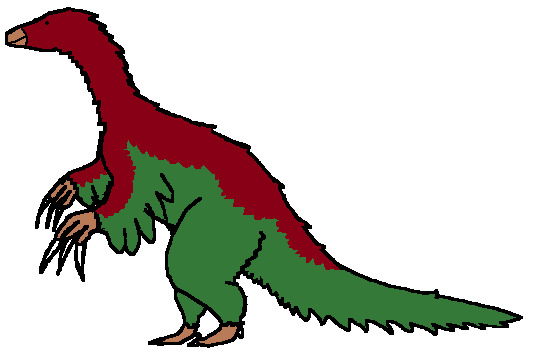
Nothronychus – Late Cretaceous (92-91 Ma)
This dinosaur is dumb. This dinosaur is SO dumb. It doesn’t sound like something that should be real, but it is. Its name is Nothronychus, and it’s a member of a group called therizinosaurs. They’re one of my favorite families of dinosaurs, but it took me so long to cover them because, honestly, I forgot something this bizarre existed.
This is a mid-sized member of its family from the western United States. That being said, it was 11 ft (3.4m) tall. Therizinosaurs were big. Nothronychus was an herbivore with a beak and blunt, leaf-shaped teeth. Its winglike arms may have been used to grasp tree branches, but we aren’t sure. The first Nothronychus bone to be found was part of the skull called the squamosal. This was originally thought to be a skull belonging to a primitive ceratopsian named Zuniceratops, but as more remains were discovered, we learned it was something much different, and much more recently understood.
Let’s talk about therizinosaurs as a group. They were some weird-ass dinosaurs. For starters, they’re herbivorous theropods. They’re part of the group called Coelurosaurs, which includes birds, dromaeosaurs, and tyrannosaurs. Like ceratopsians, they fist evolved in Asia and migrated to North America, probably across what we would today call the Bering Sea. Tens of millions of years later, our ancestors would reach North America using the same bridge. Therizinosaurs stood in that semi-upright, kangaroo-like stance we used to think all bipedal dinosaurs used. They were insulated by simple feathers, probably a mix of short, soft down and longer quills. Their most famous feature is their claws, which were used for… um, we don’t really know. Defense? Feeding? They had to be important somehow, considering how big they are.
Therizinosaur research has a long and convoluted history. Therizinosaurus, was originally described in 1954 as a turtle. Because the first name trumps all others, the sole species is still named Therizinosaurus cheloniformis (Turtle-shaped reaper lizard). Therizinosaurs were pretty much tucked away in a bin for the next 20-odd years until it was proposed that, hey, maybe we’re way off-base with this one and it’s actually a theropod. This idea was contested, as all new ideas in science are. Those of us who are less-inclined to believe in science point to this as evidence for science being dogmatic, but at the heart of every objection to a new theory is the simple question: “What’s your proof?” The proof was a little shaky back then, but it was suggested that therizinosaurs were theropods who were like big, prehistoric anteaters who used their claws to dig into insect mounds. It wasn’t until the decade was almost over that we finally found proof they were theropods, when a forelimb of Therizionsaurus was identified.
Despite that, we still kept finding therizinosaurs and thinking they were other things. Nanshiungosaurus was originally thought to be a sauropod, for example. Then, Segnosaurus was found, and interpreted as a fish-eater. A group of theropods was named after it, the segnosaurs. Although, then there was debate over whether or not they were actually sauropods, or maybe related to prosauropods. Their small heads and long necks were cited as evidence for that.
Thanks to computers and other big jumps in technology, paleontology advanced an awful lot in the 90s. We were suddenly able to set a lot of facts about extinct animals straight. We learned that just about every animal that would eventually be in this group was misidentified, and that ‘segnosaurs’ were actually just therizinosaurs, and that we had done kind of a bad job of recognizing them in the past. It wasn’t exactly expected that an entire oddball clade of dinosaurs was still out there waiting to be discovered. Paleontology can be fun like that.
Anyway, we now know they were big, weird herbivores with long claws for some reason. The two biggest, and honestly, most likely reasons, are for grasping branches and for defense. Nobody would want to fuck with an animal with giant scythe fingers, no matter how mild-mannered. We tend to think of herbivores as universally peaceful, but if you’ve ever seen that video of the jeep being chased by a giraffe, they’re that big for a reason. Hell, the most homicidal animals in Africa are hippos, because they’re just that fucking pissed all the time. If an herbivore has a weapon, it’s because it’s not afraid to use it.
Nothronychus is a relatively obscure animal. It appeared in a Discovery Channel special called When Dinosaurs Roamed America, where the main thing it did was slap a Dromaeosaurus and then die in a fire. Yeah. Pop culture representation for this group usually comes in the form of Therizinosaurus, which has shown up in a few places. It’s mentioned in Jurassic World as one of the animals whose DNA was used to create Indominus rex. It also shows up in ARK: Survival Evolved, where it has a short neck and a big head with no beak. The feathers aren’t exactly accurate either, but I don’t want to split too many hairs right now. It’s also apparently in the anime Dinosaur King, although I don’t know enough about that to elaborate.
#nothronychus#therizinosaurs#theropods#dinosaurs#cretaceous#mesozoic#paleoart#palaeoart#paleoblr#palaeoblr#paleontology#palaeontology#prehistoric
67 notes
·
View notes
Text
SUCHIOMIMUS AT THE RIVERBANK

In the wooded mid-Cretaceous estuaries of North Africa, a Suchiomimus tenerensis comes by a riverbank waiting for any Lepidotes fish to come by...
A dino-mite gift for this year’s Earth Day.
0 notes